We Compared 21 Cold Email Infrastructure Tools (18 Of Them Are Trash)
If you’re using Gmail, Outlook, or SendGrid for cold email, you’re burning your domain.
No DNS control.
No IP rotation.
No blacklist alerts.
No warm-up that actually works.
They’re built for marketing not cold outreach.
We tested 21 infrastructure tools under the same setup.
Only 3 kept us in the inbox.
This blog shows:
→ What actually matters for cold email infrastructure in 2025
→ Which tools to trust
→ What to avoid at all costs
The cold email game has changed in 2025—adapting to new best practices is essential if you want to stay effective and ahead in lead generation and sales.
Read this if you want replies not spam folders.
Let’s get into it.
TL;DR – Most Tools Break When You Scale
We tested 21 cold email infrastructure tools across 30 inboxes.
Only 3 tools gave full control over deliverability:
✅ Custom domains
✅ Dedicated IPs
✅ Warm-up that works
✅ Real-time blacklist and DNS monitoring
18 others failed — either lacking DNS access, using shared IPs, or breaking under volume.
If you’re serious about cold outreach in 2025, you can’t trust tools that hide your infra. Specialized cold email providers offer private infrastructure, improved deliverability, and dedicated support—unlike mainstream platforms like Gmail or Outlook, which are not designed for cold email campaigns.
You need infrastructure built for outreach, not newsletters.
This guide breaks down what works, what doesn’t, and which stack is worth your time.
Why Cold Email Infrastructure Matters in 2025 (And How We Tested 21 Tools to Prove It)
In 2025, inboxing is all about control, not creativity.
You’re Probably Using the Wrong Kind of Tool
Gmail. Outlook. Sendgrid.
These are ESP tools, built for marketing, not cold outreach.
They don’t give you:
- DNS access
- Dedicated IPs
- Warm-up systems
- Blacklist alerts
- Or even control over sending limits
So when you hit scale, or just try to send cold, your domain gets flagged.
Fast.
You need infrastructure tools, the ones built to manage how your emails get delivered, not just send them. A dedicated cold email platform offers deliverability optimization, easy setup, and seamless integration with your existing email services, making it far more effective than generic email tools.
How to Set Up Cold Email Infrastructure (Before You Even Pick a Tool)
Setting up your cold email infrastructure is the single most important step you can take to keep your cold email campaigns out of spam folders and in the primary inbox.
Before you even think about which cold email tool to use, you need a rock-solid foundation that gives you control, credibility, and compliance.
Get this right, and your cold emailing efforts will actually reach real people—not just spam filters.
Here’s how to build an email infrastructure that sets you up for cold email success.
The Core Components You Need
- Domain Setup - Your domain is your digital handshake. For cold email campaigns, you need a domain that’s clean, reputable, and configured for deliverability. Set up your domain with all the right DNS records—SPF, DKIM, and DMARC—to prove to email service providers that you’re legit. Skip this, and you’re basically begging spam filters to block your cold emails.
- Email Accounts - Never use your main business or personal email accounts for cold emailing. Create dedicated email accounts tied to your outreach domain. This keeps your sender reputation clean and protects your primary domain from getting burned if something goes wrong.
- Private Cold Email Infrastructure - If you’re serious about inbox placement, invest in a private cold email infrastructure tool. Look for features like automated DNS setup, custom tracking domains, and dedicated IPs. These give you the control you need to avoid shared infra headaches and maximize your cold email deliverability.
- Inbox Warmup - Don’t blast out 500 cold emails on day one. Warm up your email accounts by gradually increasing send volume. This builds a positive sender reputation with email service providers and helps your cold emails land in the primary inbox instead of the spam folder.
Step-by-Step Setup Process
- Register Your Domain - Start by registering a fresh domain that reflects your brand. This is the foundation of your cold email infrastructure.
- Set Up DNS Records - Configure your DNS records for SPF, DKIM, and DMARC. These records authenticate your emails and are non-negotiable for avoiding spam filters. Most modern cold email infrastructure tools offer automated DNS setup—use them to get this done in just a few clicks.
- Create Email Accounts - Set up dedicated email accounts on your new domain specifically for cold email campaigns. Keep these separate from your main business accounts to protect your sender reputation.
- Configure Your Email Infrastructure Tool - Choose a cold email infrastructure tool that makes setup easy. Follow the tool’s onboarding process to connect your domain, set up DNS records, and provision your email accounts. The best tools handle most of the technical setup for you, so you can get started with just a few clicks.
- Warm Up Your Inbox - Begin sending a small number of emails from each account, gradually increasing the volume over several weeks. This slow ramp-up is critical for building trust with email service providers and ensuring your cold emails reach the inbox.
Common Mistakes to Avoid
- Insufficient Warmup - Skipping or rushing the warmup process is a fast track to the spam folder. Take the time to build sender reputation before launching full-scale cold email campaigns.
- Poor DNS Setup - Failing to properly configure SPF, DKIM, and DMARC records will tank your email deliverability. Double-check your DNS setup or use a tool that automates this for you.
- Shared IP Pool - Using a shared IP pool means your deliverability is at the mercy of other senders. If someone else on your IP gets blacklisted, your cold emails will suffer too. Opt for dedicated IPs whenever possible.
- Lack of Blacklist Monitoring - If you’re not monitoring blacklists, you won’t know when your domain or IP gets flagged. This can silently kill your cold email campaigns. Use tools that alert you to blacklist issues in real time.
- Inadequate Content Quality - Sending generic, low-value, or spammy content will get you marked as spam, no matter how good your infrastructure is. Always follow industry best practices for content and personalization.
By building your cold email system on a solid infrastructure—complete with proper DNS setup, dedicated email accounts, and ongoing blacklist monitoring—you’ll dramatically improve your email deliverability and get better results from your cold email campaigns.
Don’t cut corners. Invest in the right setup, follow industry best practices, and keep a close eye on your sender reputation for the best possible inbox placement.
The 5 Things Every Cold Email Infrastructure Must Get Right
Here’s what actually affects inbox placement:
DNS Control
You need full control over SPF, DKIM, and DMARC. No shortcuts.
IP Reputation
Shared IPs = shared risk. A stranger’s spam affects your inbox.
Deliverability Warm-Up
You can’t go from 0 to 500/day. Real tools ramp gradually, with real replies, not fake opens.
Free Email Deliverability Test & Audit: Check your mailboxes’ health
Volume Scaling
Gmail throttles. Outlook blocks. You need tools that manage velocity, rotation, and volume thresholds.
Monitoring + Alerts
You should know if your IP gets blacklisted, before it destroys your sender score. Deliverability reports help you monitor inbox placement and experiment with different IPs or services to improve results.
If your current tool doesn’t do all five, it’s just a fancier version of Gmail.
Next up, here are the only 3 tools we trust to handle cold email at scale in 2025.
🟢 Tier 1: Infrastructure You Can Actually Trust
The top tools stand out due to their advanced features such as multi-IP provisioning, SSL certificates, domain masking, and API access, which provide enhanced control and customization.
Out of 21 tools, only 3 gave full control, consistent inboxing, and didn’t break under pressure.
They weren’t the biggest names.
They were just built right.
#1. Mailforge – Affordable Cold Email Infrastructure Built for Speed and Scale
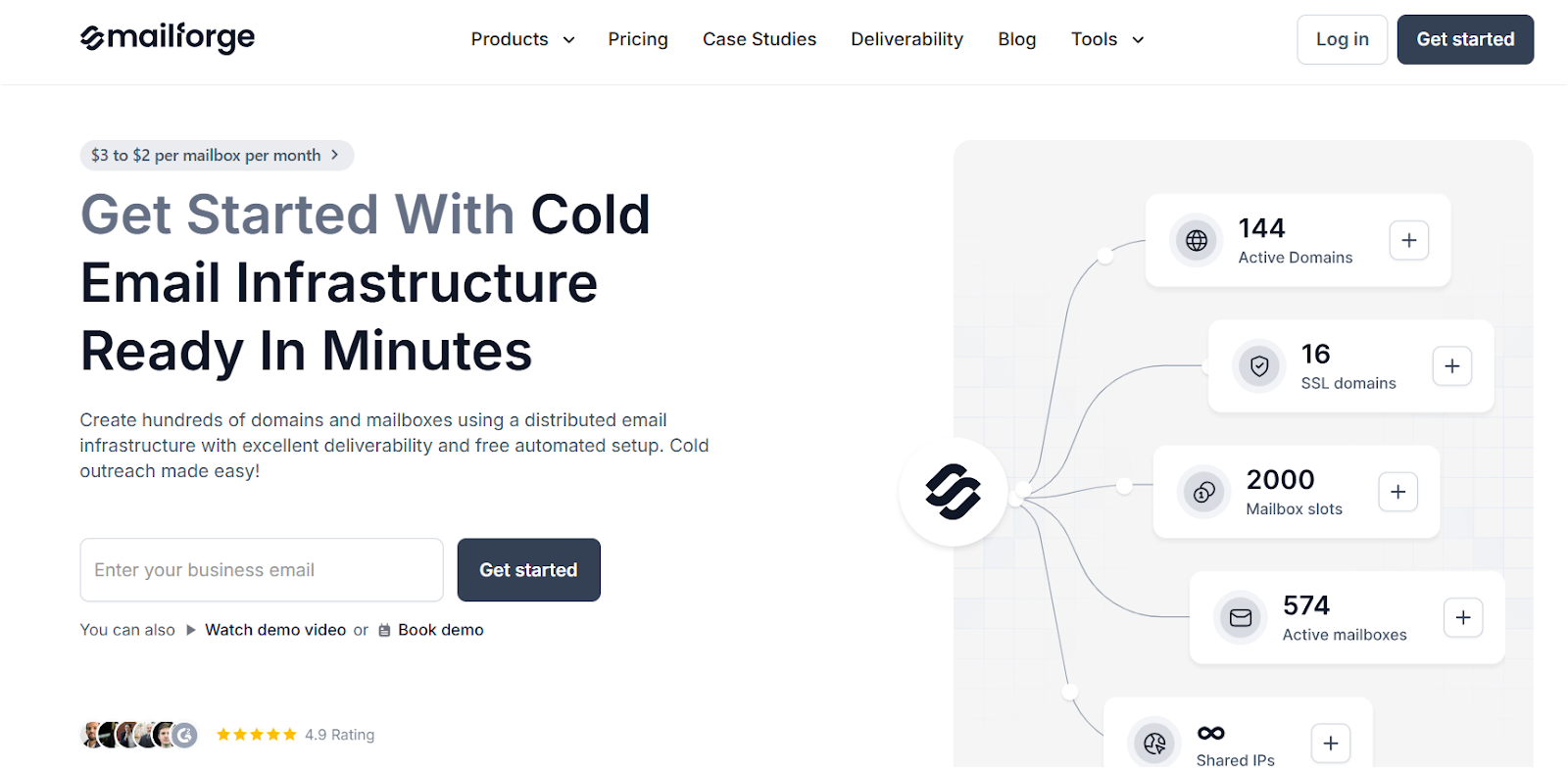
Most people overpay for infrastructure they don’t understand.
Then they wonder why inboxes get flagged after week two.
Mailforge was built to fix that.
What Mailforge Actually Does?
It’s a distributed cold email infrastructure tool that lets you spin up hundreds of domains and mailboxes in minutes, no DNS knowledge needed.
Every domain is pre-configured with SPF, DKIM, DMARC, and a custom tracking domain. Mailforge also includes custom domain tracking as part of its automated setup, helping to improve deliverability and campaign effectiveness.
It handles warm-up, rotation, and hosting, all under one roof.
You can manage everything inside one dashboard.
No duct tape. No 10-tab workflows.
Features That Actually Matter
- Automated DNS Setup
- Mailbox Slots (replaceable inboxes)
- Unified Inbox (manage multiple accounts in one dashboard) — Useful for consolidating email management from various sources.
- SSL & Domain Masking
- Forge Expert Onboarding Sessions
- Works with Any Cold Outreach Tool
Mailforge Pricing
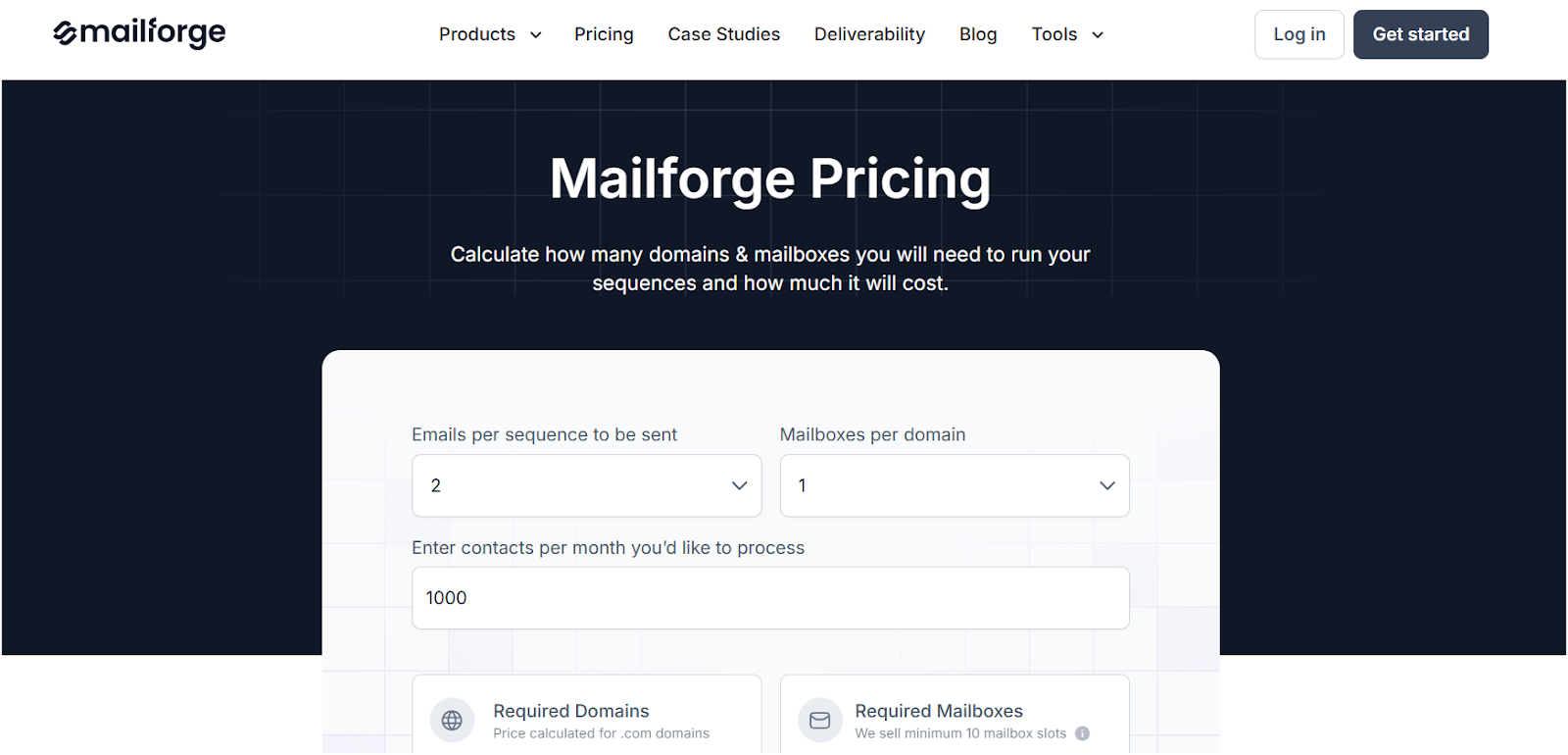
Pros and Cons of Mailforge
Best For
- Solo founders or consultants
- Agencies scaling to 100+ inboxes
- Anyone who wants fast, cold email infrastructure without touching DNS
Need complete backend control or dedicated IPs?
Let’s talk Infraforge, built for teams that need total control.
#2. Infraforge – Full-Control Private Cold Email Infrastructure for Serious Senders
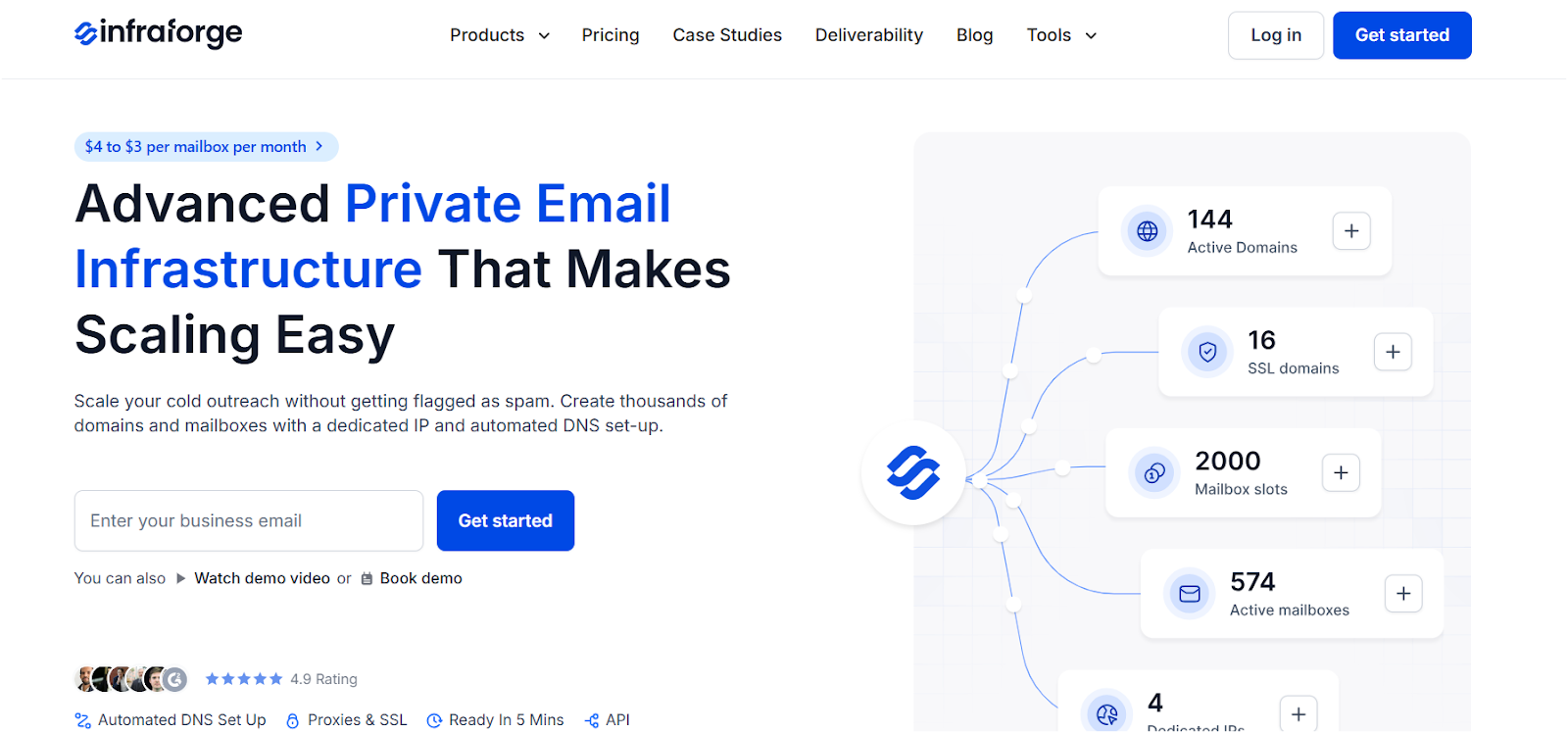
Mailforge gets you started fast.
Infraforge takes the training wheels off.
If you're sending high volume, managing multiple teams, or want dedicated IPs with full backend control, Infraforge was built for you.
What Infraforge Actually Does?
Infraforge is a private, dedicated cold email infrastructure.
You get your own IPs, automated DNS setup, domain warmup, and inbox hosting, with full control over every layer. Infraforge leverages dedicated servers to provide enhanced control over deliverability, reputation management, and scalability.
It’s built for agencies, teams, or enterprise senders who’ve outgrown shared IP setups and need reliability, scale, and security.
You can spin up 1 or 1,000 domains, monitor deliverability, and integrate with any cold outreach tool via API.
Features That Matter When You Scale
- Dedicated IPs: Isolate your sending reputation. Avoid damage from noisy neighbors.
- Multi-IP Provisioning: Spread load and rotate sends at scale.
- Support for secondary domains: Scale outreach and protect your primary domain’s reputation.
- Masterbox™ Dashboard: View all mailbox activity across all domains in one place.
- Infraforge API: Plug into any tool, manage everything via code.
- Automated DNS Setup + Bulk Management: DMARC, SPF, DKIM done for every domain instantly.
- SSL + Domain Masking: Secure, branded redirect links to avoid spam traps.
Pricing
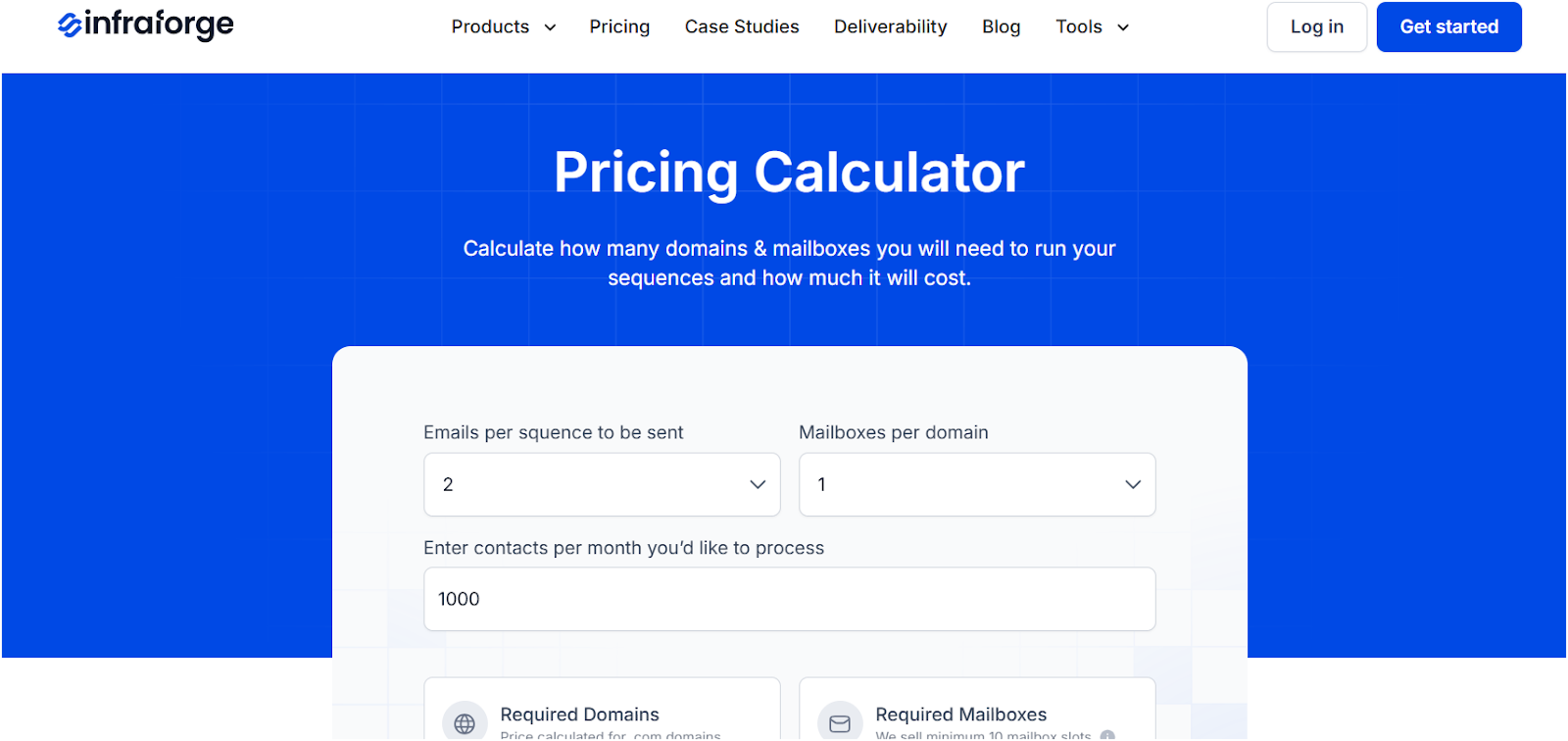
Pros and Cons of Infraforge
Best For
- Cold email agencies managing >100K sends/month
- Founders or RevOps teams running outbound at scale
- Anyone burned by shared infra and blacklists
- Enterprise ops need stability, speed, and control
Infraforge isn’t cheap infra.
It’s the kind of setup you move to when email is your pipeline, and downtime means lost revenue.
Next up, a solid middle-ground tool that works well if you're more technical and want flexibility: Mailreef.
#3. Mailreef – Flexible Infra With Smart Recommendations (But Needs Tech Confidence)
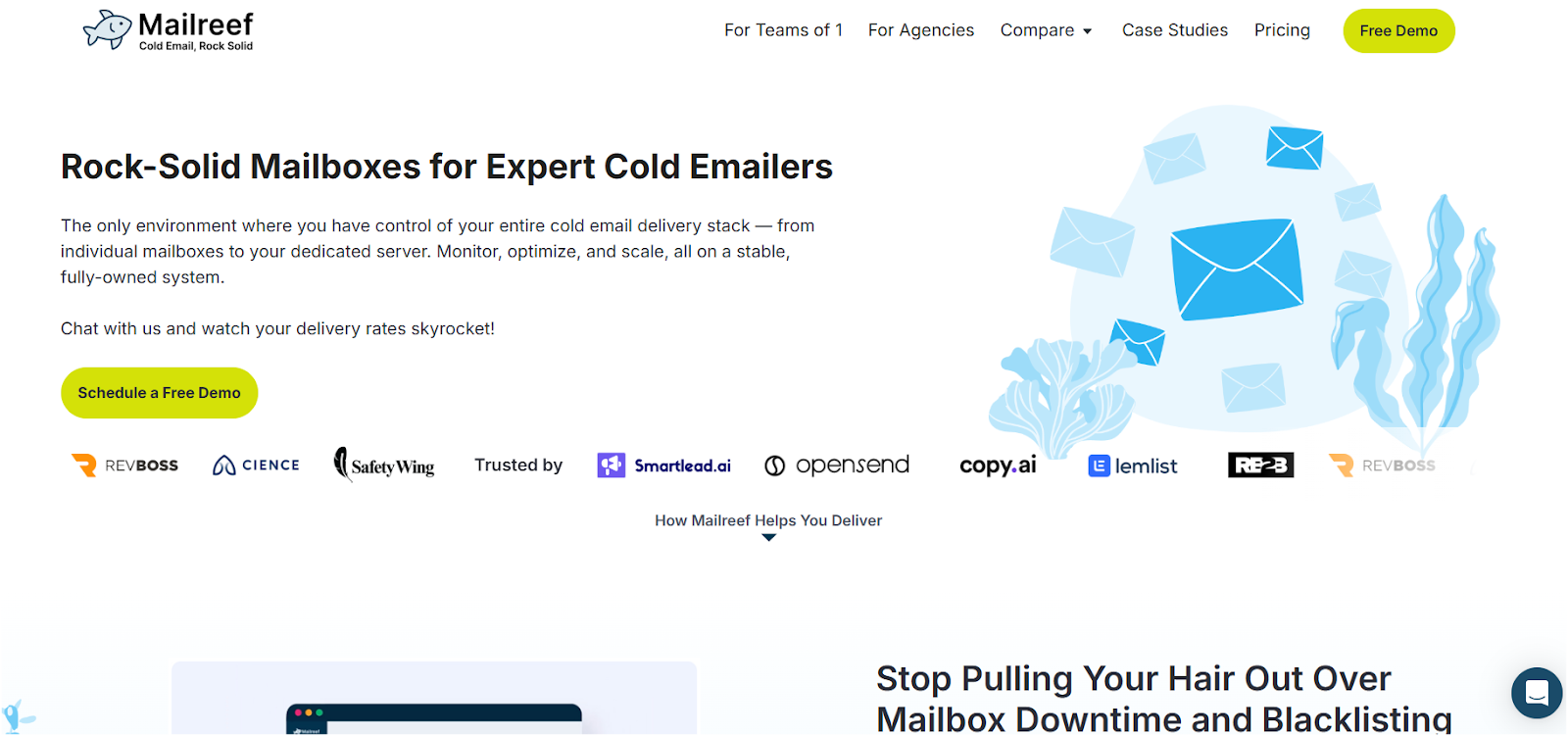
Mailreef doesn't hold your hand.
But if you know what you're doing, it can work surprisingly well.
It's not as beginner-friendly as Mailforge.
And it doesn't offer full backend control like Infraforge.
But it does give you a balance of customization and deliverability, with some smart infrastructure recommendations built in.
What Mailreef Actually Does
Mailreef lets you create and manage cold email infrastructure with flexibility.
You get domain + mailbox provisioning, deliverability guidance, and custom limits based on your monthly contact volume. Mailreef manages and optimizes multiple mailbox accounts to ensure reliable sending and high deliverability.
It works with most sending tools and includes a calculator that recommends how many domains/mailboxes you need to hit your goals without triggering spam filters.
Features That Stand Out
- Infra Calculator: Helps you avoid overloading inboxes by suggesting ideal domain/mailbox ratios.
- Deliverability-First Setup: Smart sending limits, warm/cold ratios, and configuration best practices are baked in.
- Support for cold email sequences: Automate structured outreach and improve reply rates.
- Integrates with Smartlead, Instantly, Lemlist : Just infra — use your preferred sender.
- Flexible Domain/Mailbox Management: Scale as needed, with reasonable control.
Pricing
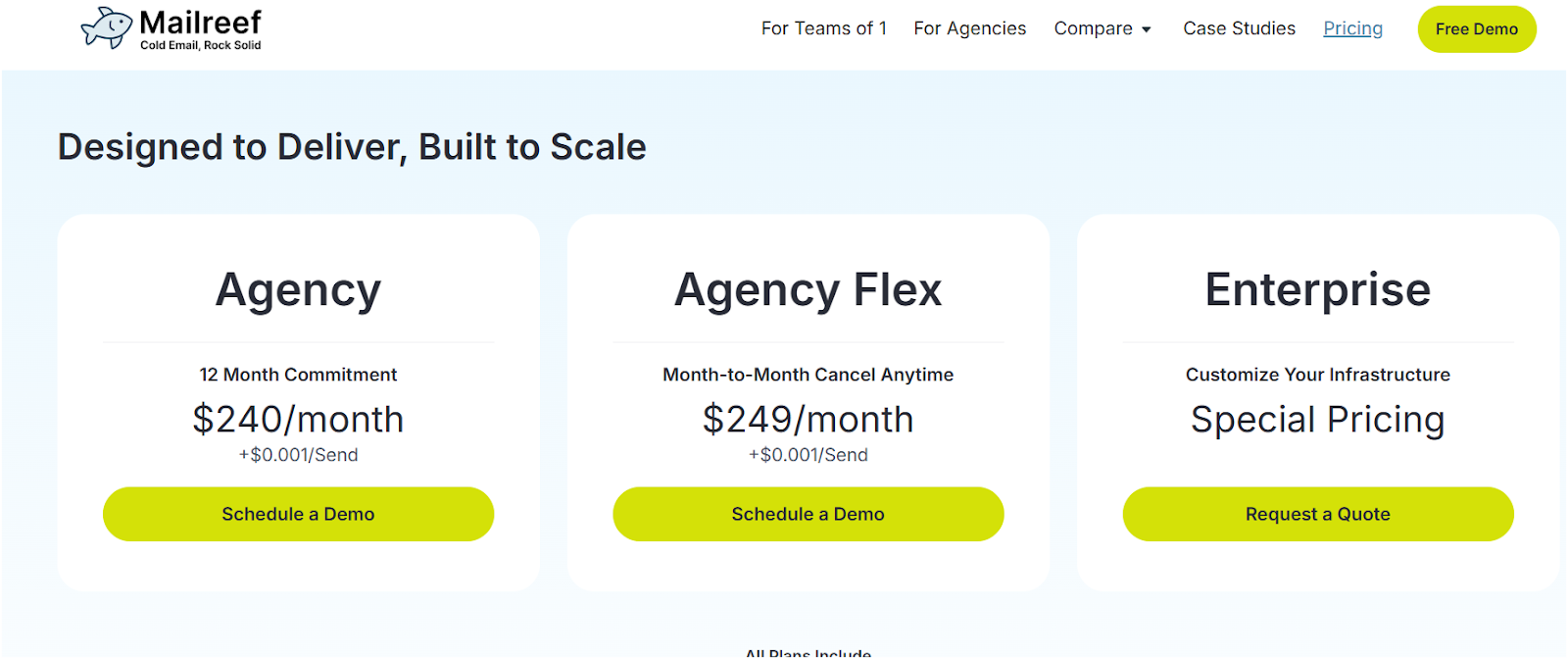
Note: You pay per estimated infrastructure size, not a fixed per-mailbox cost like Mailforge or Infraforge.
Pros and Cons of Mailreef
Best For
- Teams that want flexibility but don’t need full backend control
- Mid-size agencies that already understand infrastructure basics
- Users upgrading from ESPs but not yet ready for dedicated IP setups
Mailreef is solid, if you’re willing to think through your infrastructure strategy.
But if you're scaling hard or need total control, you’ll hit limitations fast.
Now let’s talk about the “almost good” tools, the ones that show promise but break down when you actually send at scale.
🟡 Tier 2: The “Almost There” Tier – These Cold Email Infrastructure Tools Are Fine, But Risky
Some tools look promising on paper.
Decent UI. Good onboarding. Maybe even a few solid reviews.
But once you start sending real volume, things fall apart.
We tested five of these “almost there” infra tools.
They’re not trash. But they’re not reliable for scale either.
- Mailscale
- Mailmodo
- Inbox Flow
- Halon
#4. Mailscale – Fastest Inbox Creation, Built for Cold Email at Speed
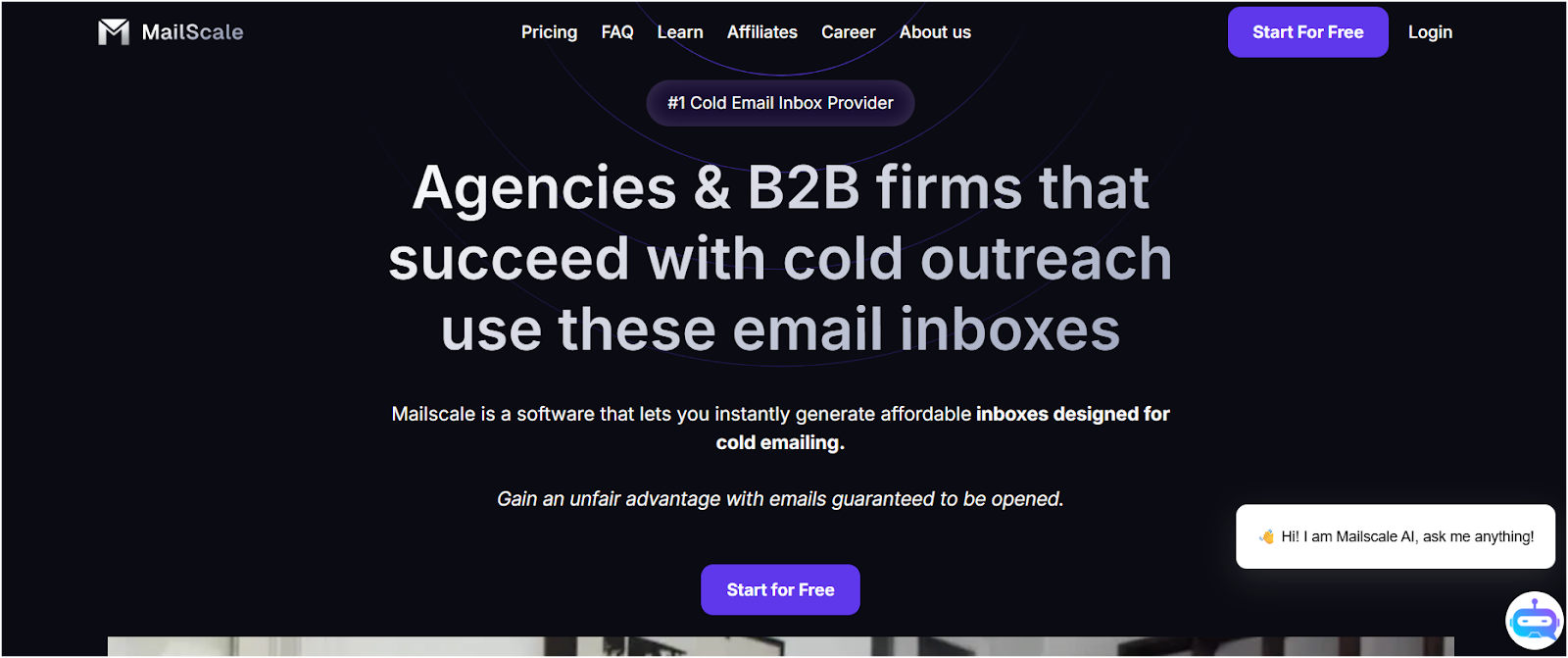
If you want to create 50+ inboxes in under a minute, without touching DNS, Mailscale is built for you.
It's dead simple. No tech skills needed.
Just pick a domain, click a button, and export inboxes straight into your outreach tool.
And it's not just fast, users consistently report strong deliverability and a solid support experience.
What Mailscale Actually Does
Mailscale lets you create cold email inboxes at scale, instantly.
You can spin up 50, 500, or even 1,000 mailboxes, pre-warmed and ready to go.
It's optimized for speed, affordability, and simplicity, with automated domain setup, inbox generation, and built-in deliverability guarantees.
It's not a full-featured backend platform like Infraforge.
It's a “just press go” engine for teams that want to launch fast.
Mailscale Features That Stand Out
- Instant Inbox Generation: Create dozens or hundreds of email accounts in seconds.
- No DNS Work Required: SPF, DKIM, DMARC — all automated. No config headaches.
- Plug-and-Play: Export inboxes into Smartlead, Instantly, Lemlist, or any cold email tool.
- Deliverability Guarantee: 95–100% inbox rate or your money back.
- Support That Works: Real people. Fast replies. Highly rated by users.
Mailscale Pricing
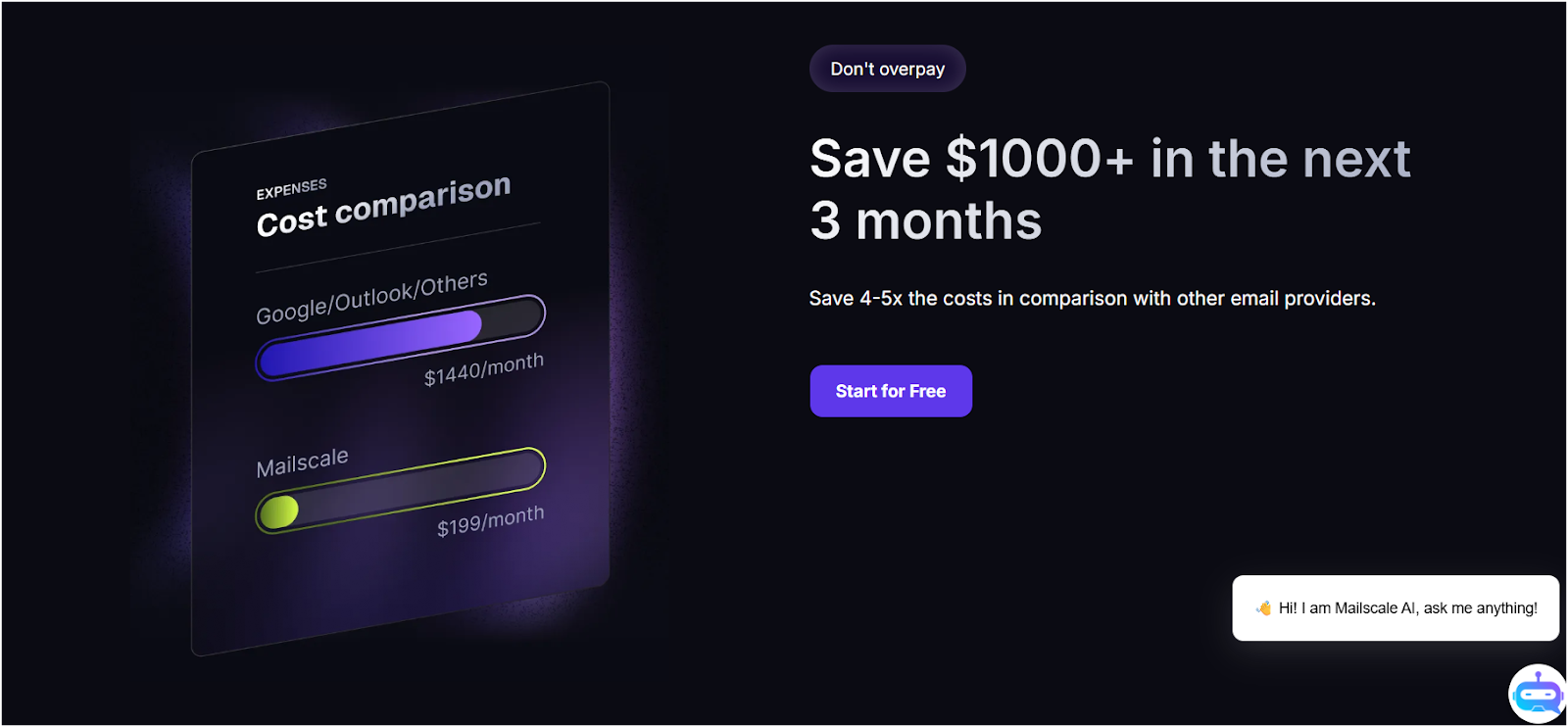
Pros and Cons of Mailscale
Best For
- Founders and SDRs who need inboxes fast
- Cold email agencies scaling 10–50K sends/month
- Teams that want plug-and-play inboxes without touching DNS
- Users are tired of Gmail/Outlook limits
Mailscale isn’t for power users who want IP rotation or deep deliverability analytics.
But if you want to go from 0 to “live campaign” in 5 minutes, and it just needs to work, this is the fastest route.
Up next: Let’s look at Mailmodo, a tool with promise but limited transparency where it matters most.
#5. Mailmodo – Great for Interactive Emails, But Not Built for Cold Outreach
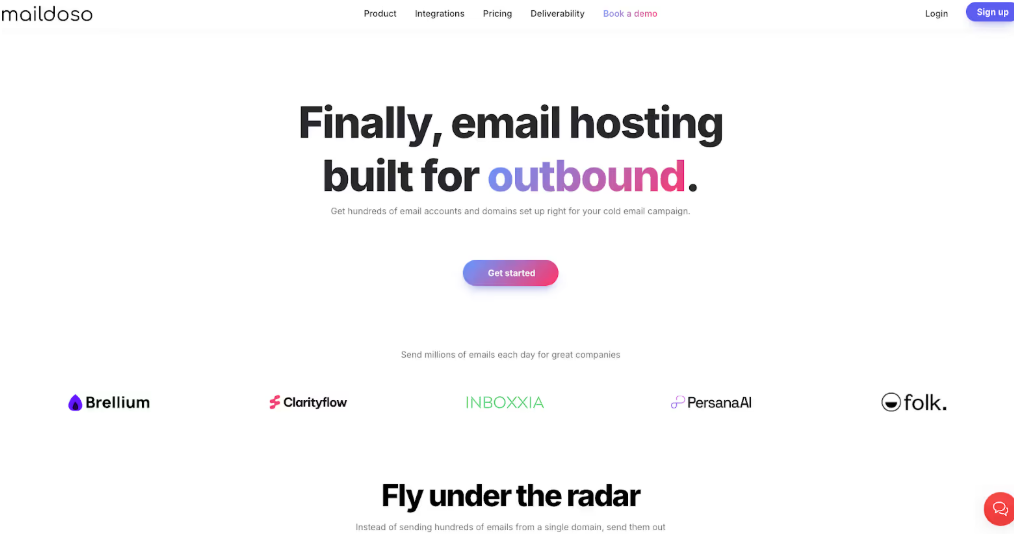
Mailmodo, often confused as a cold outreach infra tool is actually an email marketing platform.
It helps in: drag-and-drop builders, polls, quizzes, AMP features, and beautiful branded campaigns.
That's great for marketing teams.
But if you're looking for cold email deliverability, domain warm-up, or inbox rotation, this isn't it.
What Mailmodo Actually Does?
Mailmodo lets you build interactive HTML and AMP-based email campaigns.
It's focused on marketing automation, not deliverability infrastructure.
You can use it for newsletters, onboarding flows, surveys, and user feedback loops.
It integrates with tools like HubSpot, Mailchimp, Segment, and Shopify.
But there's no inbox creation, no dedicated cold email infra, and no warm-up system.
Features That Stand Out
- AMP/HTML Email Builder: Add forms, polls, star ratings, quizzes, and calendar links directly inside emails.
- Prebuilt Journeys + Automation: Works for post-signup drip, webinar flows, eCommerce abandon carts, and more.
- Detailed Engagement Analytics: View clicks, open rates, session times, heatmaps, and more.
- API + Integrations: Includes webhooks, custom events, and access to CRMs like HubSpot and Intercom.
Mailmodo Pricing
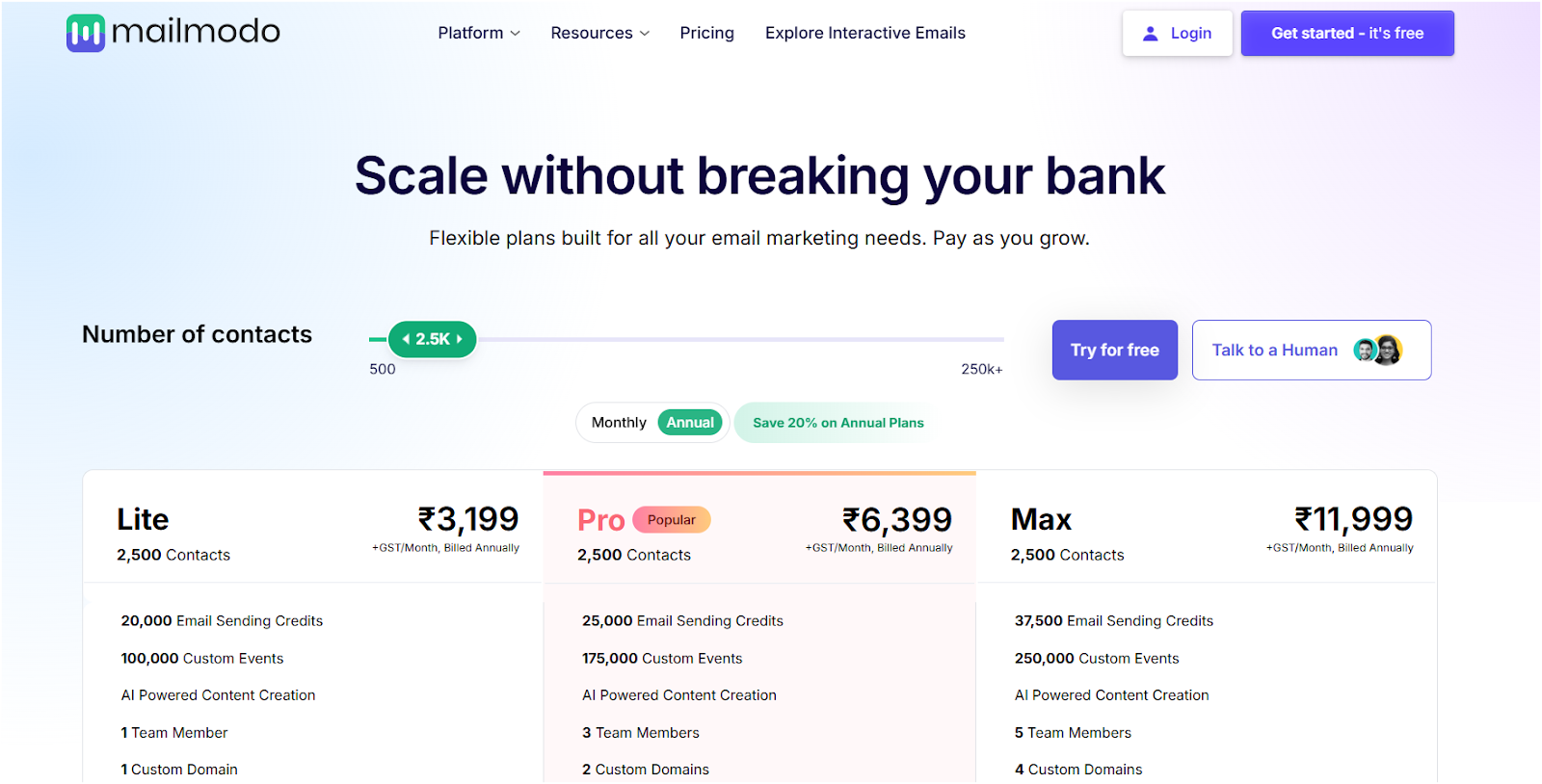
Each plan includes AI-powered content, journeys, and AMP blocks.
You can scale up contacts and API usage with each tier.
Pros and Cons of Mailmodo
Best For
- B2B SaaS teams running lifecycle or retention email
- Marketing teams looking to replace Mailchimp or ActiveCampaign
- Founders wanting to design emails without HTML knowledge
- eComm brands doing cart recovery or promotions
If you’re sending cold email at scale, Mailmodo is the wrong tool.
No inbox creation. No DNS. No warm-up. No deliverability control.
It’s a great email marketing platform, but not a cold outreach infrastructure tool.
We Tried 3+ Maildoso Alternatives To Build Cold Email Infrastructure
Next up: Inbox Flow- promising interface, but can it actually deliver when scaled?
#6. InboxFlow – Decent Setup Automation, But Risky on Compliance and Trust
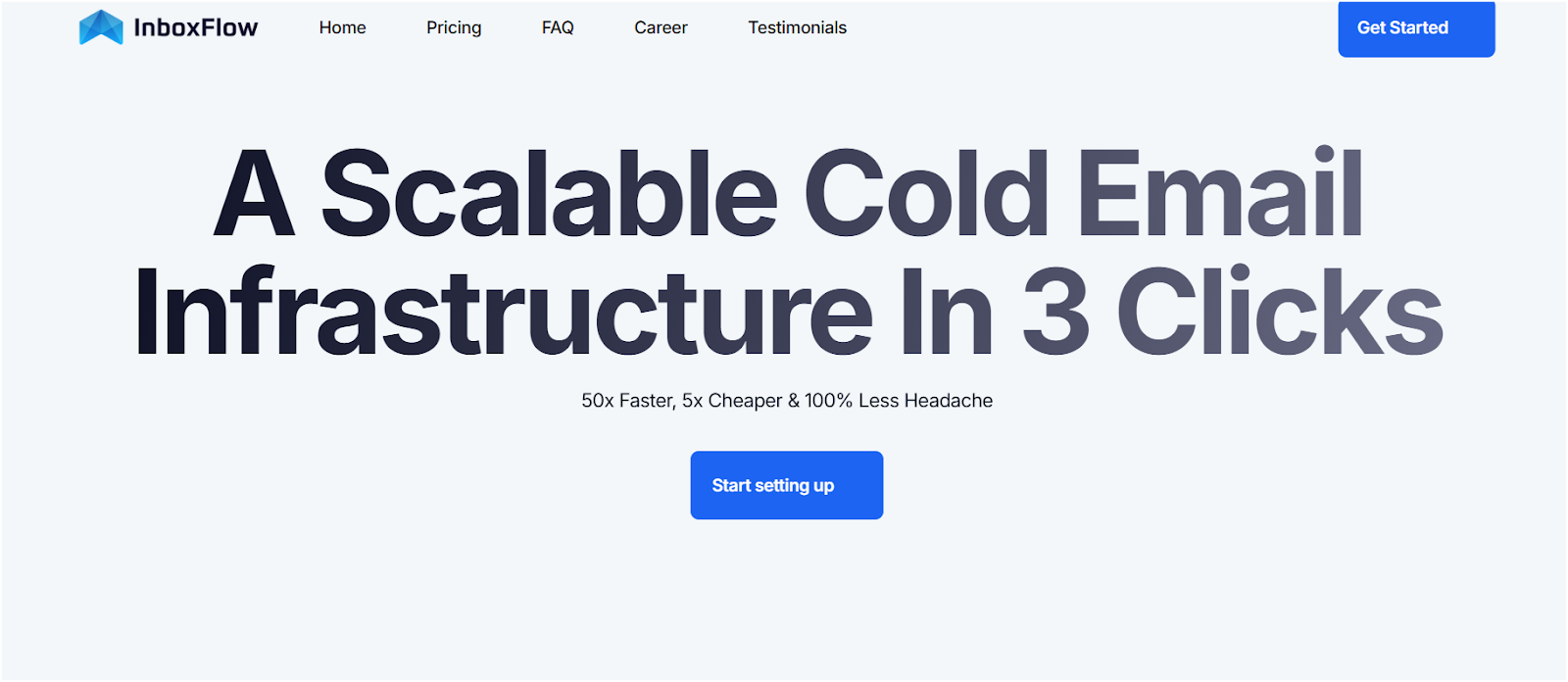
InboxFlow pitches itself as an “all-in-one cold email setup tool.”
It automates inbox creation, handles DNS config, and integrates with tools like Instantly and Smartlead.
But behind the clean UI and pricing, there are serious red flags especially around compliance, consent, and user trust.
What InboxFlow Actually Does?
InboxFlow helps users automate the creation of cold email inboxes.
It offers domain setup, SPF/DKIM/DMARC config, and bulk export options.
Its main pitch?
Speed. You can host and launch 15+ inboxes without touching DNS or doing manual setup.
But: inbox setup is only one part of infrastructure.
Deliverability, privacy practices, and warm-up transparency still matter — and this is where things break down.
Features That Stand Out
- Automated DNS Setup: SPF, DKIM, and DMARC configured automatically.
- Bulk Inbox Hosting: Host up to 15 inboxes per plan, plug into your sender via CSV.
- One-Click Integration: Works with Instantly and Smartlead, no manual syncing.
- Simple Pricing Tier: One plan, flat rate, no usage-based surprises.
Inbox Flow Pricing
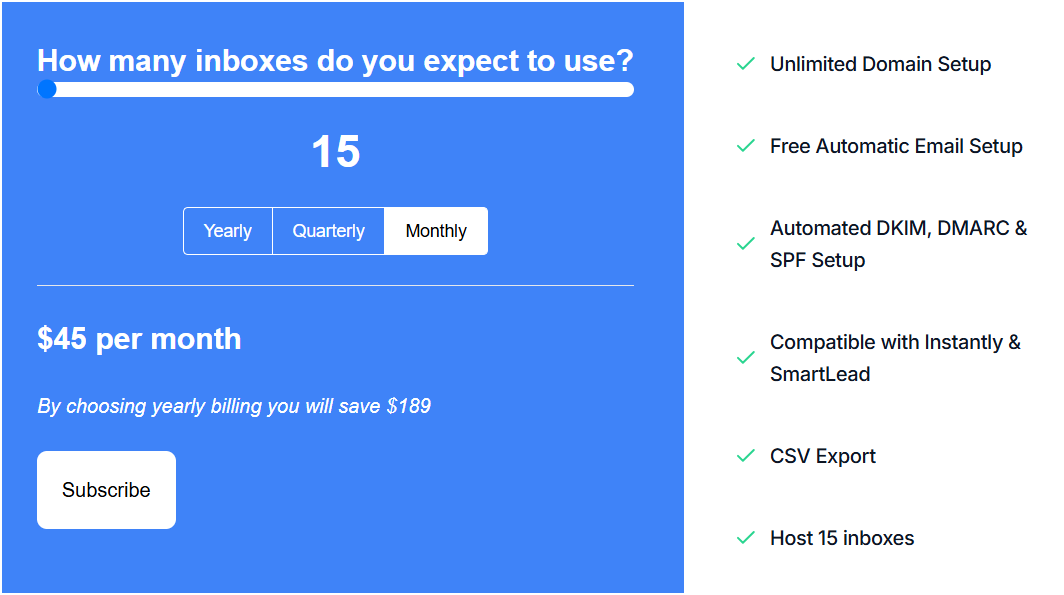
There are no visible pricing tiers beyond 15 inboxes, scaling might require custom setup or multiple plans.
Pros and Cons of InboxFlow
Best For
- Cold email beginners needing quick inbox setup
- Freelancers testing outbound campaigns
- Agencies needing to spin up a few test domains fast (if compliance isn’t a concern)
InboxFlow might get you started fast.
But if your business depends on compliance, brand trust, and stable sending, you need to tread carefully.
Next up: Halon, built for security, but is it even meant for cold outreach?
#7. Halon – Enterprise Email Infrastructure Built for Security, Not Cold Outreach
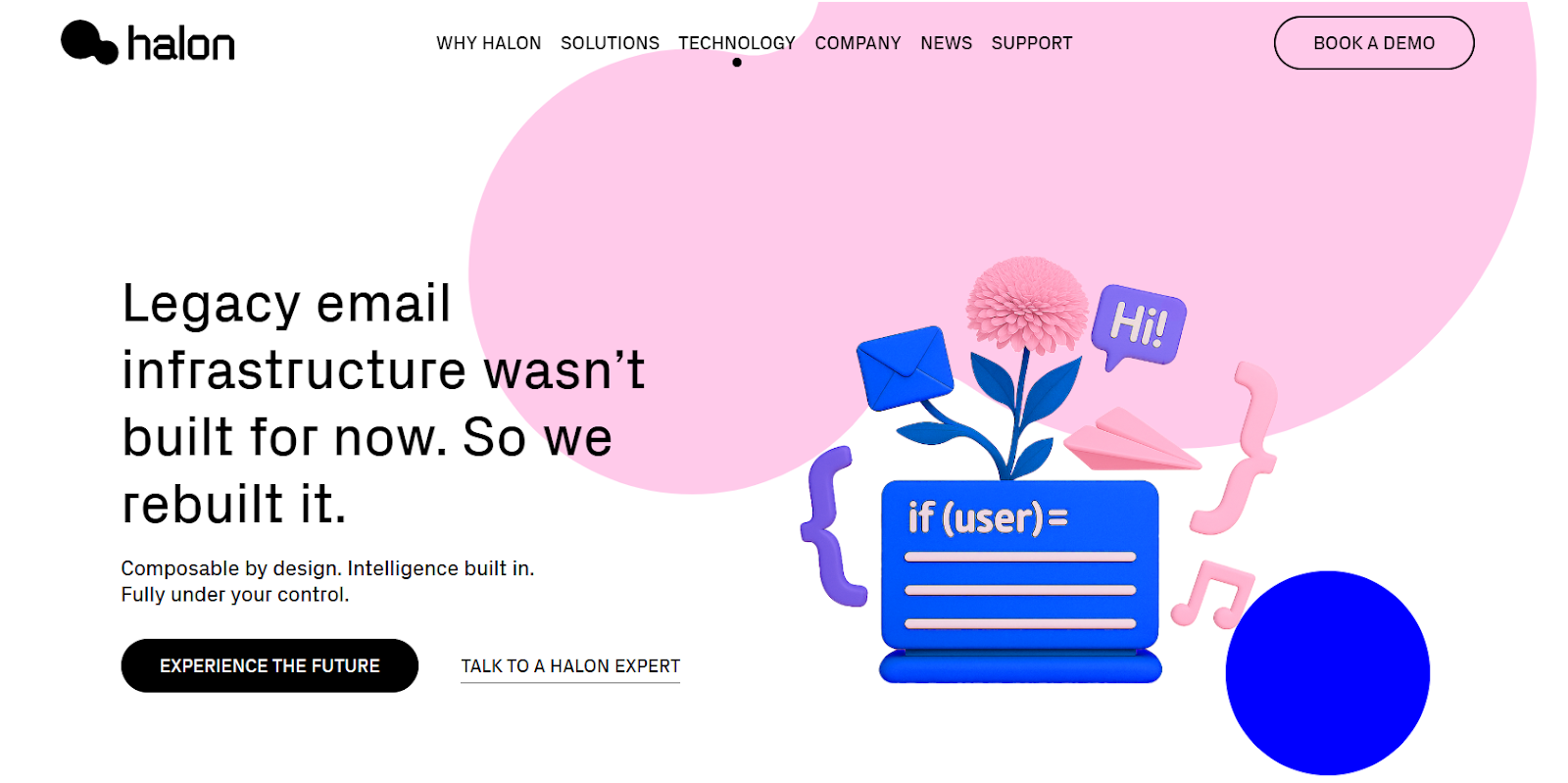
Halon isn't your typical cold email tool.
enterprise-grade infrastructure designed for mailbox providers, ESPs, and compliance-heavy teams.
Think: secure SMTP relay systems, low-code customization, and modular architecture for large-scale senders.
This isn't built for SDRs or cold email agencies, it's built for telcos and enterprise postmasters.
If you're a marketer looking to spin up inboxes or warm domains, you're in the wrong place
What Halon Actually Does?
Halon offers composable email infrastructure, a hybrid between build-your-own and buy-what-you-need.
It powers over a trillion emails per year for clients like KPN, One.com, and Ziff Davis.
Key use cases include:
- Running secure, large-scale transactional email flows
- Email protection for ISPs and hosting providers
- Customized routing, filtering, and deliverability logic
- Low-code scripting for infrastructure-level operations
But there's no support for cold outreach infra, no inbox warm-up, domain rotation, or mass mailbox setup.
Features That Stand Out
- Composable Infrastructure: Fully flexible deployment models, cloud-native or on-prem.
- Email Security & Filtering: Use Halon Protect to build advanced mail protection layers.
- Low-Code Scripting Engine: Write custom SMTP rules, logic, and policy enforcement.
- Enterprise-Grade Support & SLA: Used by telecom-grade providers with high NPS (75).
- API-First Architecture: Deep backend access, built for developers and sysadmins.
Halon Pricing
Halon doesn't list pricing publicly.
Expect custom, enterprise-tier pricing with onboarding calls and contracts.
If you're not running at least 1M+ monthly sends or hosting email infra for clients, Halon likely won't talk pricing.
Pros and Cons of Halon
Best For
- Large mailbox providers, ISPs, or hosting companies
- Enterprise teams replacing legacy SMTP infrastructure
- Companies that need full security, compliance, and control
- Technical teams managing transactional or system email at scale
Halon is not a tool for launching your outbound campaigns tomorrow.
It’s a powerful backend system, if you're building an email platform, not just sending from one.
🔴 Tier 3: Cold Email Infrastructure Tools That Look Good, But Break Under Pressure
Out of the 21 tools we tested, these five kept popping up in communities, review sites, and agency stacks.
So we stress-tested them.
They couldn’t handle the pressure.
Here’s what we found:
- Inframail
- Mission Inbox
- Mailin
- Outreach2Day
- Inbox Automate
#8. Inframail – Looks Scalable, But Breaks When You Actually Scale
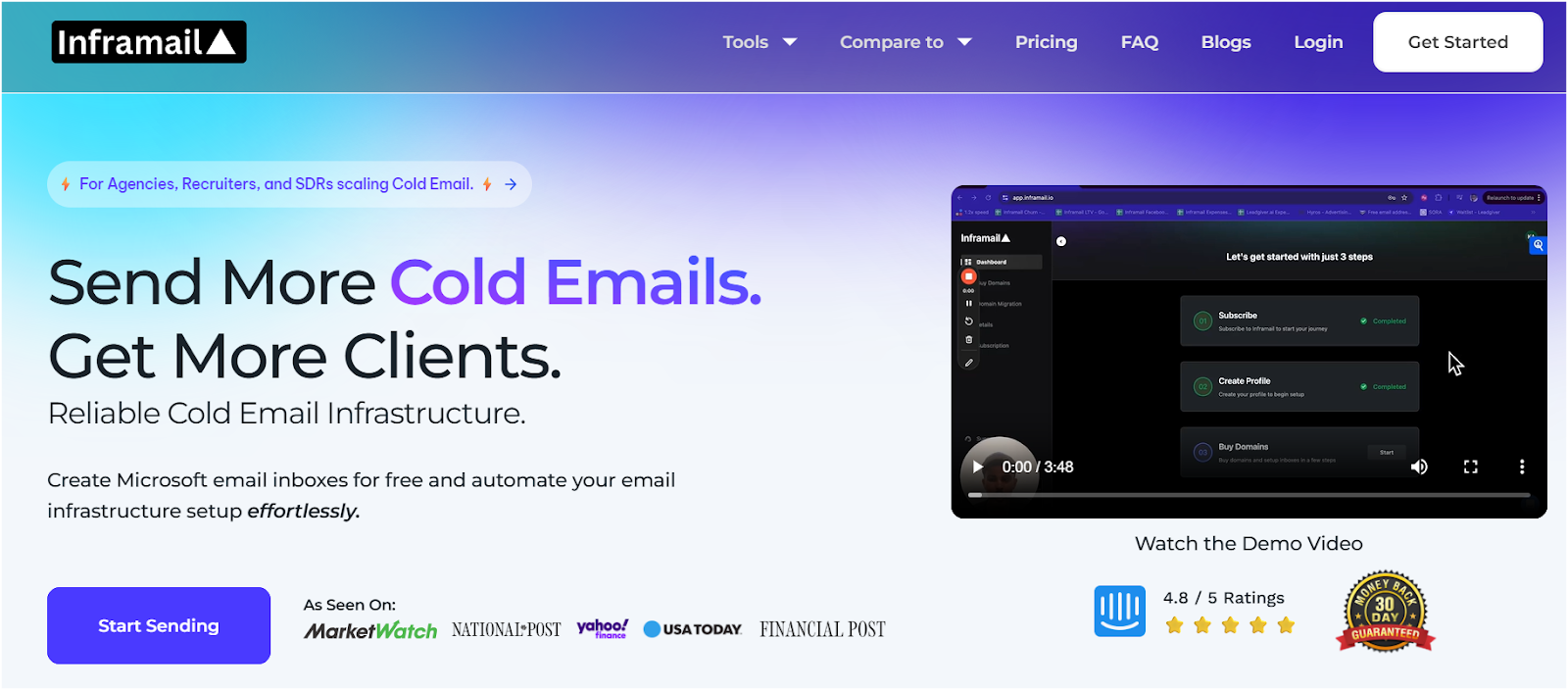
Inframail pitches itself as a cold email infrastructure game-changer: automated Microsoft inbox provisioning, unlimited mailboxes, blacklist monitoring, “Phantom” redirect links, and one‑flat‑rate pricing.
At first glance, it ticks a lot of boxes until you scale email volume.
What Inframail Actually Does
- Automated domain purchase + inbox creation (Microsoft-based only)
- Unlimited mailboxes under one plan
- DNS setup (SPF, DKIM, DMARC), redirect domain masking
- Blacklist check + auto‑delisting dashboard
- Export-ready accounts for Smartlead, Instantly, ReachInbox, etc.
Features That Sound Great
- Unlimited Inboxes on entry plan, no per-mailbox charge
- Dedicated IP included in basic plan ($99/month)
- Fast provisioning — inboxes in minutes
- Built-in deliverability tools like blacklist monitoring and redirect masking
Inframail Pricing

- Unlimited Plan: $99/month (+ tax), includes 1 dedicated IP, unlimited Microsoft inboxes, 5 domain setups/day.
- Agency Pack: $249/month, 3 dedicated IPs, unlimited inboxes, 15 domain setups/day
Pros & Cons of Inframail
Best For
- Solo founders or small agencies focused on Microsoft-based cold outreach
- Teams sending <10k cold emails/day that just want “set and forget” delivery
- Those needing a quick, no-setup Gmail alternative
Inframail is a solid, cost-effective entry point, especially with dedicated IPs and unlimited inboxes.
But if you're serious about volume scaling or need full infra control (Gmail support, DNS, API), it's likely to crumble under pressure.
Shared infrastructure is convenient until things go wrong.
#9. Mission Inbox – Looks Like a Cold Email Tool, But It’s Not Even in the Game
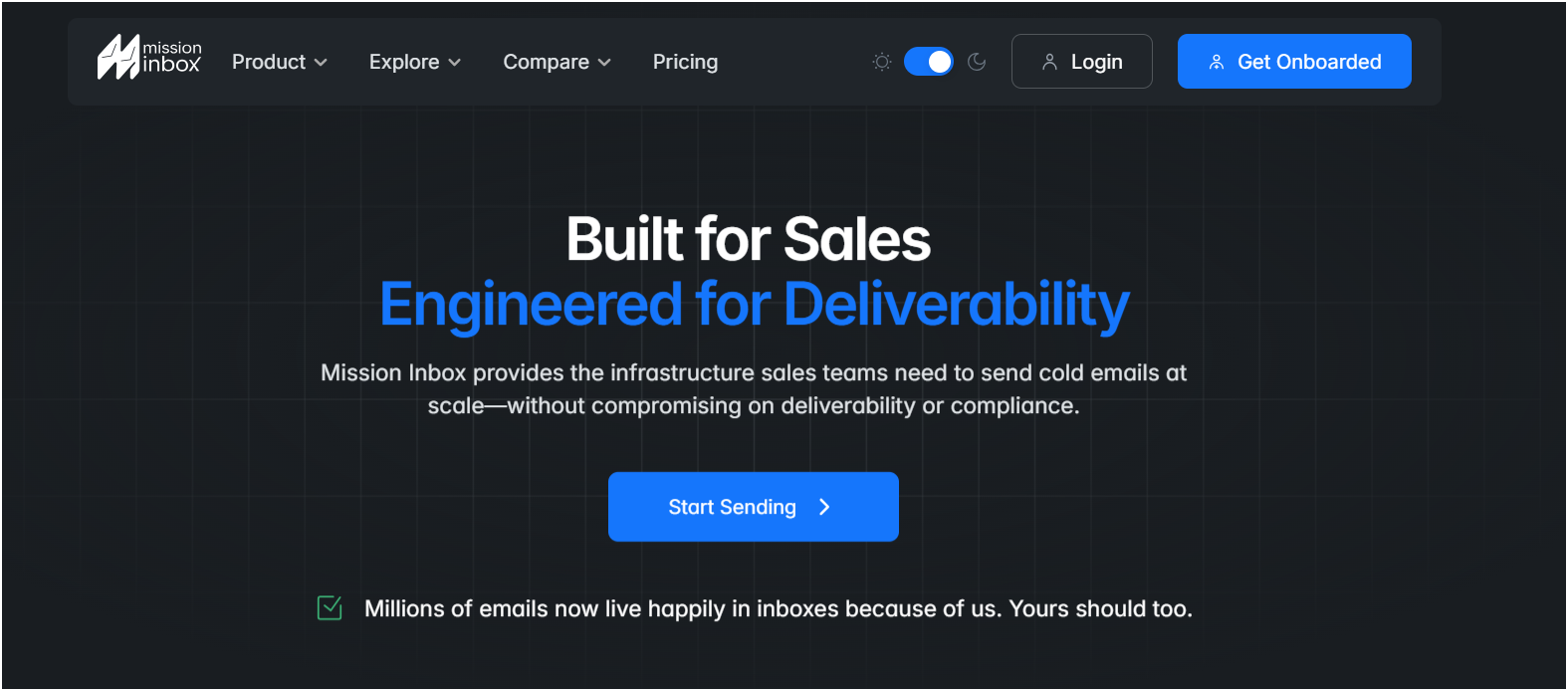
Mission Inbox gets mentioned in a few cold email forums and Slack groups.
You'd expect it to be a sending infrastructure platform. It's not.
What Mission Inbox (aka Mission Box Solutions) Actually Does?
Mission Inbox is part of Mission Box Solutions, a service-disabled veteran-owned staffing firm.
They offer:
- Direct hire recruiting
- RPO (recruiter on demand)
- Resume subscription plans
- Military veteran recruiting programs
- Healthcare and IT staffing for DoD and federal contracts
There is no connection to cold outreach or email deliverability.
The confusion likely comes from the name “Inbox”, but this is a people business, not a platform.
Features and Offerings
- Recruitment Marketing Services: Employer branding, job board promotion, and engagement campaigns.
- Talent Acquisition Solutions: Staff augmentation and resume search packages.
- Specialty Hiring: Cleared talent for government/defense contracts and licensed healthcare staff.
- Employer Portal + Job Board Access: Used by HR teams for hiring, not by outbound sales teams.
Mission Inbox Pricing
There's no pricing listed publicly for any cold email features, because none exist.
All pricing relates to staffing models like direct hire, resume finder subscriptions, and recruiter hourly billing.
Pros and Cons of Mission Inbox
Best For
- Government contractors hiring cleared personnel
- Healthcare systems need vetted hires
- Employers need veteran-focused recruiting
Mission Inbox isn’t just not ready for cold outreach.
It’s not even in the same category.
If you’re evaluating email infrastructure tools, this one should be disqualified immediately.
#9. Mailin.ai – Affordable Private Infra, But Still Finding Its Feet
Mailin positions itself as a low-cost, private cold email infrastructure for teams scaling outbound.
It's not trying to be fancy.
Instead, it aims to offer private infrastructure, better deliverability, and mailbox automation, without bloated pricing.
Sounds promising.
But as you'll see, the tradeoff for affordability is maturity.
And in cold email, immature infrastructure can cost you real replies.
What Mailin Actually Does?
Mailin offers private, low-cost email infrastructure with full domain + DNS setup, mailbox provisioning, and native integration with cold email tools.
They automate setup like DKIM/SPF/DMARC, use dedicated IPs, and handle onboarding in a day.
It's targeted at teams who need 200–1,000 inboxes but don't want to pay per-slot like Infraforge or Mailforge.
If you're running high-volume cold outreach and your pain point is cost-per-mailbox, this may appeal.
Mailin Pricing
✔ Includes: Dedicated IPs, full DNS automation, warmup, and dashboard
⏱10-min onboarding, 1-day infra delivery
Pros and Cons of Mailin
Best For
- Mid-to-large agencies scaling fast
- SDR teams sending 50K+ emails/month
- Anyone tired of paying $3–$7/inbox and wants private infra
- Teams with some cold email experience, not total beginners
Mailin.ai is a cost-efficient private infra option, especially if you need 200+ inboxes.
But it’s still new, so if stability and support are critical, test cautiously.
If you're OK being an early adopter, the price-to-performance ratio could pay off.
#10. Outreach2Day – High Volume, Low Friction… But Still Rough Around the Edges
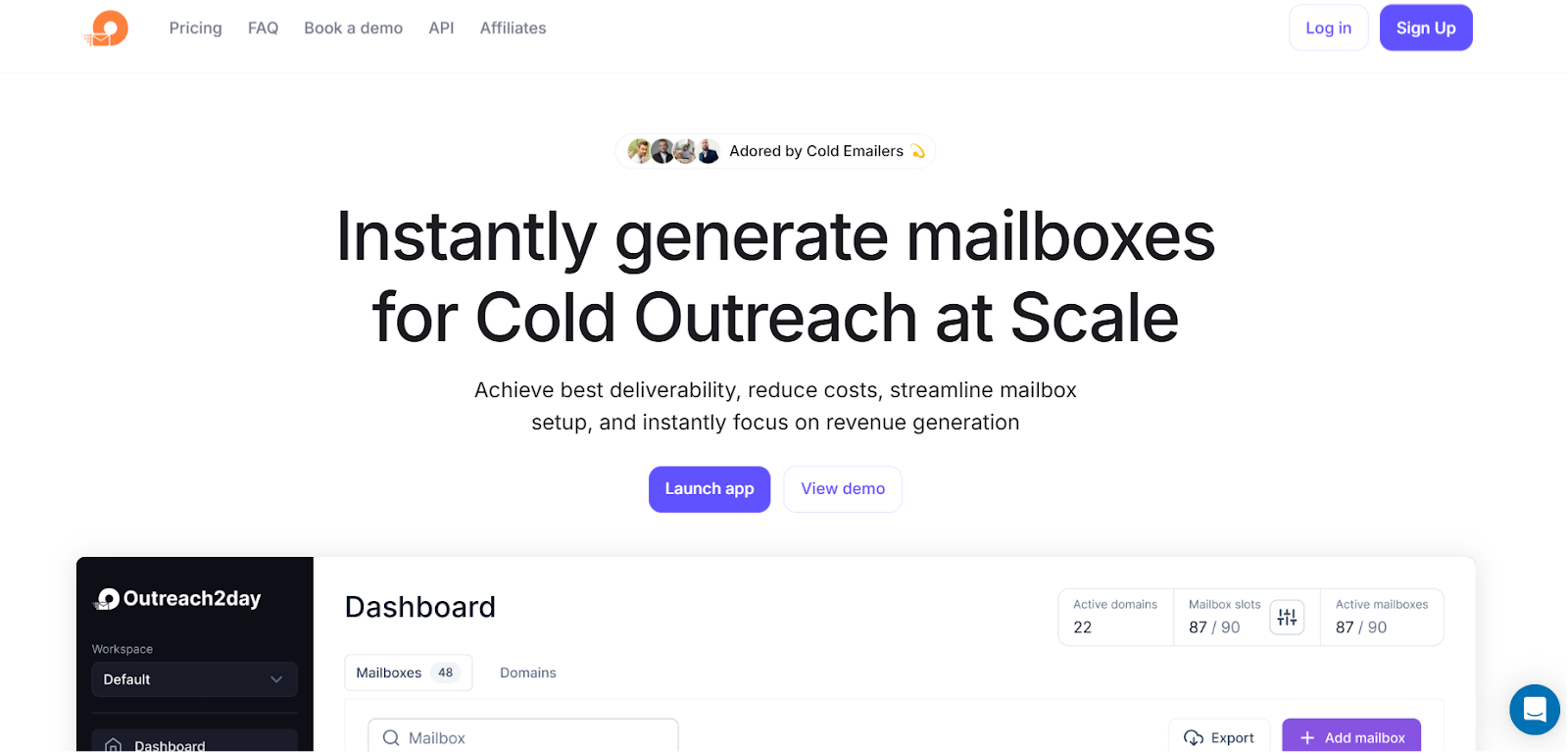
Outreach2Day claims to let you launch 50+ mailboxes in 5 minutes, automate warming, and avoid the $7-per-seat costs of Google/Outlook.
And it delivers on some of that promise.
But when you look under the hood, the experience is a mixed bag, especially around product maturity, reliability, and long-term support.
It's built for speed and affordability, not stability.
What Outreach2Day Actually Does?
It's a cold email infra tool that handles mailbox provisioning, warmup, domain setup (SPF/DKIM/DMARC), and integrates with outreach platforms like Instantly, Smartlead, and SalesHandy.
The main selling point?
$2.50 per mailbox, done in minutes, with zero Google/Outlook setup required.
Perfect for mass-scale ops… but not ideal if you're aiming for consistency over chaos.
Key Features
- Auto Mailbox Setup: Add 50+ inboxes at once, no manual work needed.
- DKIM/SPF/DMARC Automation: Fully handled behind the scenes.
- Warm-Up Emails Included: Auto-warming built into every plan.
- Blacklist Monitoring: Check if your domains/IPs get flagged.
- Ability to automate and manage multiple campaigns across different market segments: Easily run and customize outreach for various products or audiences without overlap.
- Export-Ready: 1-click sync with 99+ platforms like Instantly, Apollo, Smartlead.
- Spam Checker: Real-time content scoring for email copy.
- Live Support Chat: Available inside the app (depending on plan).
Outreach2Day Pricing
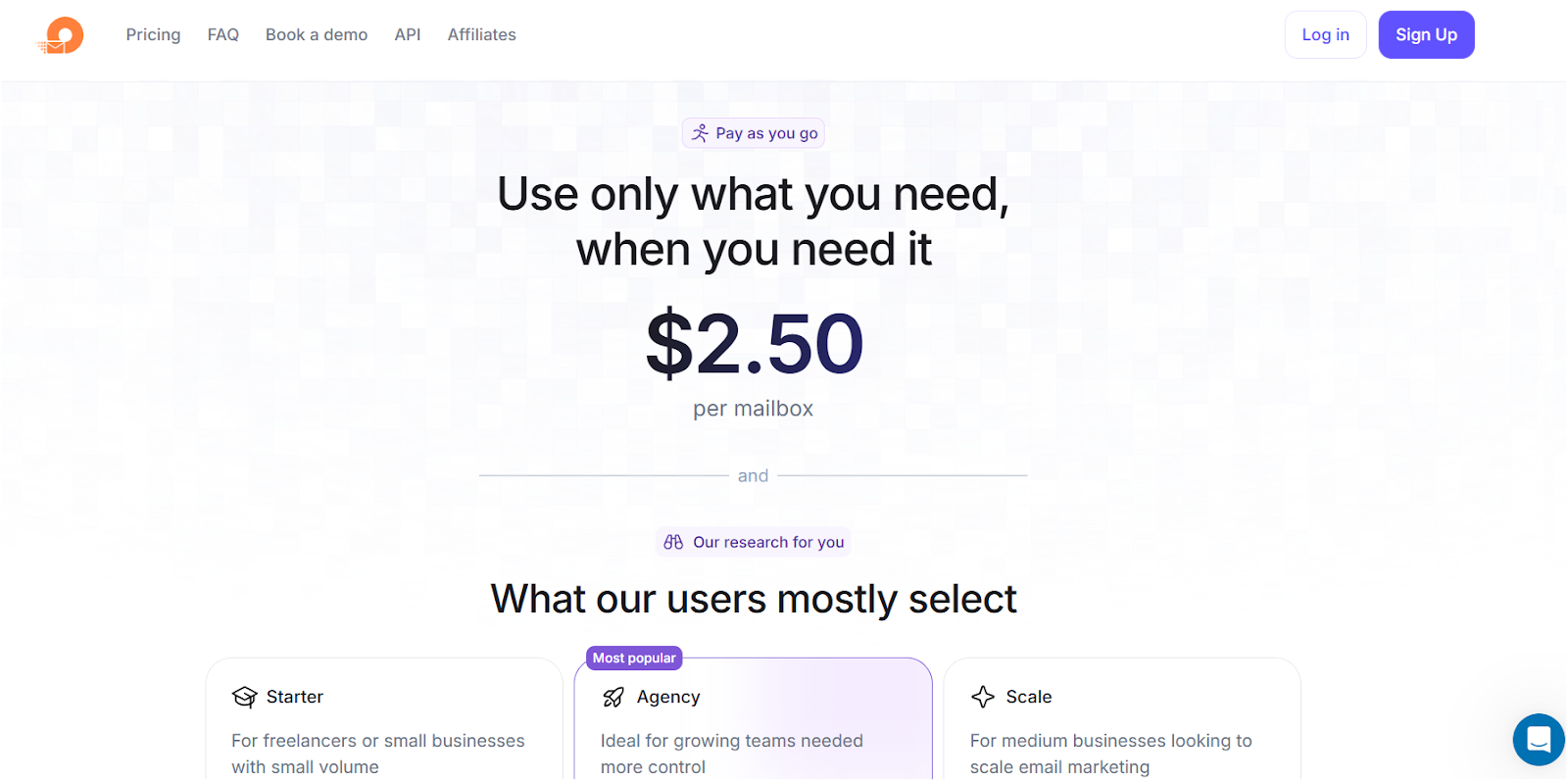
✔ No separate Gmail/Outlook fee
✔ Includes warm-up, DNS, and spam monitoring
✔ Live dashboard and centralized management
Pros and Cons of Outreach2Day
Best For
- Outreach agencies needing hundreds of mailboxes fast
- Recruiters, founders, or marketers doing scale outreach
- Users frustrated with Google/Outlook limits or pricing
- Teams needing quick mailbox rotation for outbound
Outreach2Day makes cold infra accessible and scalable, especially for budget-conscious operators.
But the tradeoff is stability and polish.
If you’re launching new domains regularly and burning through IPs fast, it’s a practical choice.
If you’re optimizing long-term sender reputation, proceed with caution.
#11. InboxAutomate – Fast Gmail Infra at Scale (But Don’t Expect Much Polish)
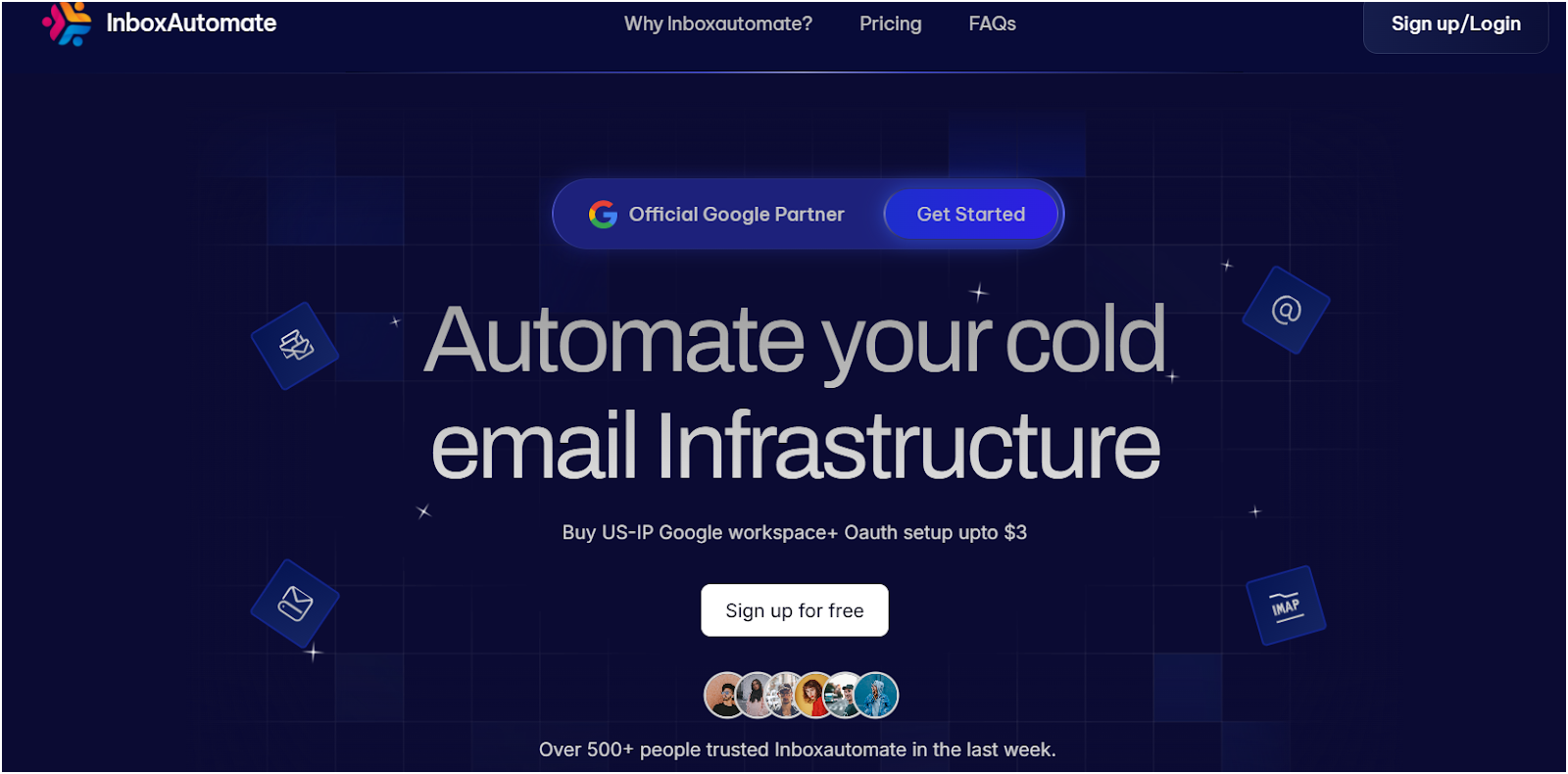
InboxAutomate is built for one thing: automating your cold email setup using Gmail accounts with US IPs, at bulk scale.
It pitches itself as a time-saver for cold emailers tired of managing Google Workspace, DNS records, or warming up inboxes manually.
It delivers most of what it promises… but with a few tradeoffs.
What InboxAutomate Actually Does?
The tool helps you:
- Buy Gmail inboxes with US IPs
- Auto-setup SPF, DKIM, and DMARC
- Bulk-create and manage domains + mailboxes
- Set profile names and images
- Export inboxes for use in cold email platforms like Instantly or Smartlead
InboxAutomate is designed to help users generate leads through effective cold email outreach.
It also offers lead gen training, enrichment credits, and template tools — but most of those are marked “coming soon.”
Key Features
- Official Google Partner: Buy Gmail mailboxes on US IPs with Oauth ready to go
- 10-Minute Setup: Full domain + mailbox setup in under 10 minutes
- Bulk Mailbox Creation: Add 10 to 100+ inboxes at once
- Automated DNS Config: DKIM, SPF, and DMARC handled automatically
- Public Profile Setup: Names + profile pics applied to all mailboxes
- 1-Click Exports: Sync inboxes with major outreach tools
- Deliverability Monitoring: Basic tools to avoid inboxing issues
- Access to Lead Gen Community + Courses: More useful for agency teams
InboxAutomate Pricing
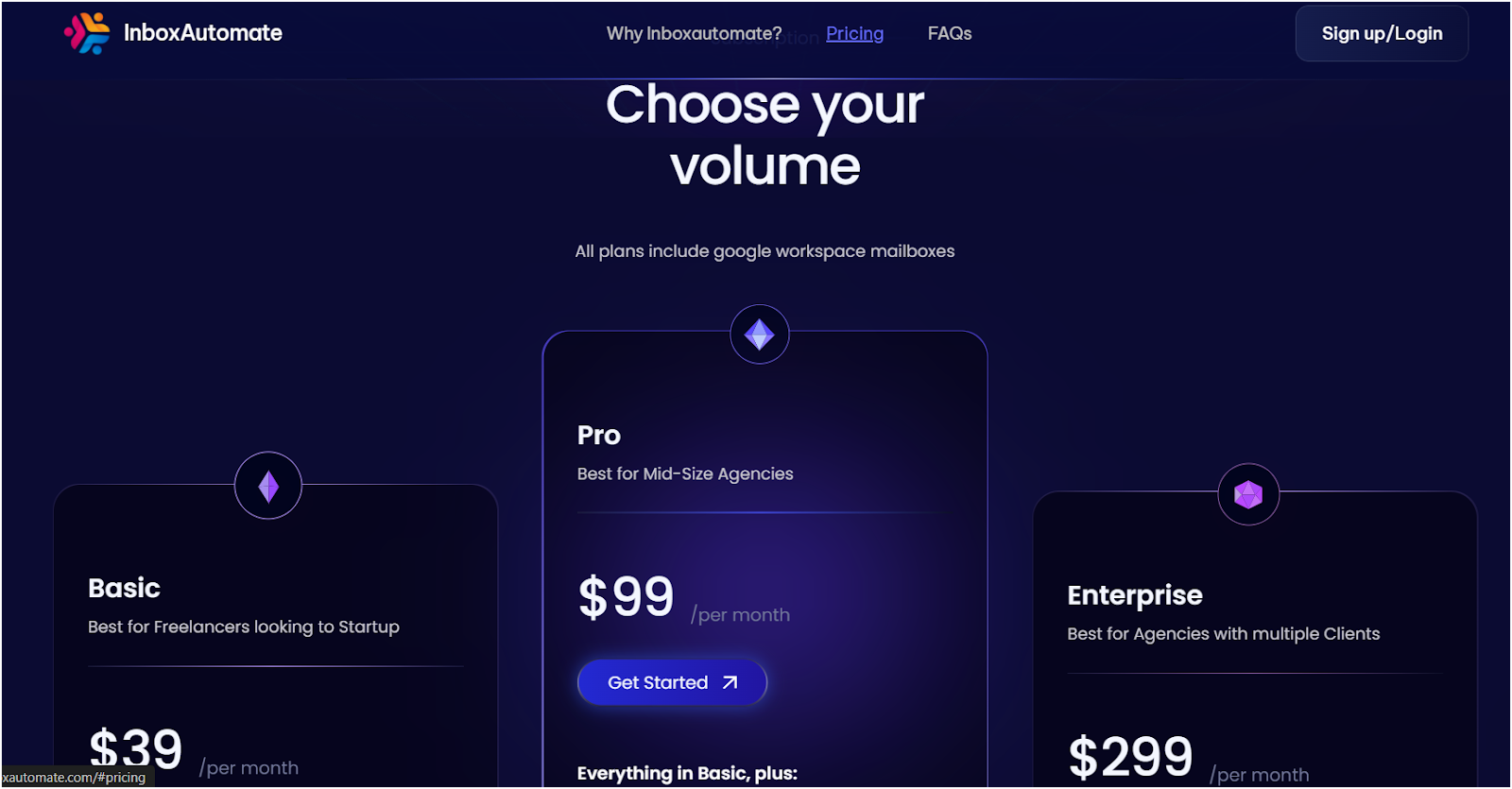
All plans include:
- Unlimited domain connects
- DKIM/SPF/DMARC automation
- Bulk editing, exporting, and profile setup
- Gmail warmup (via Oauth)
- Free access to $10K training (when launched)
- 5K verification credits + enrichment (coming soon)
Pros and Cons of InboxAutomate
Best For
- Cold emailers prefer Google Workspace accounts
- Outreach agencies scaling Gmail infra with 30–100+ inboxes
- Teams that want US IP warmup options without Outlook headaches
- Users wanting export-ready Gmail inboxes for Smartlead or Instantly
InboxAutomate makes Gmail-based cold outreach cheaper and faster, especially if you're done dealing with Google manually.
But be cautious about the “coming soon” features and occasional dashboard quirks.
It’s promising, growing fast, and worth testing if Gmail is core to your infra.
🔴 Tier 4: Just Not Worth Your Time (High Risk / Low ROI Tools)
- Zapmail
- Supermail
- Scaledmail
- Premiuminboxes
- Cheapinboxes.com
- Frost Mailer
- F60 Host
#12. Zapmail – Looks Affordable, But Raises Red Flags Fast
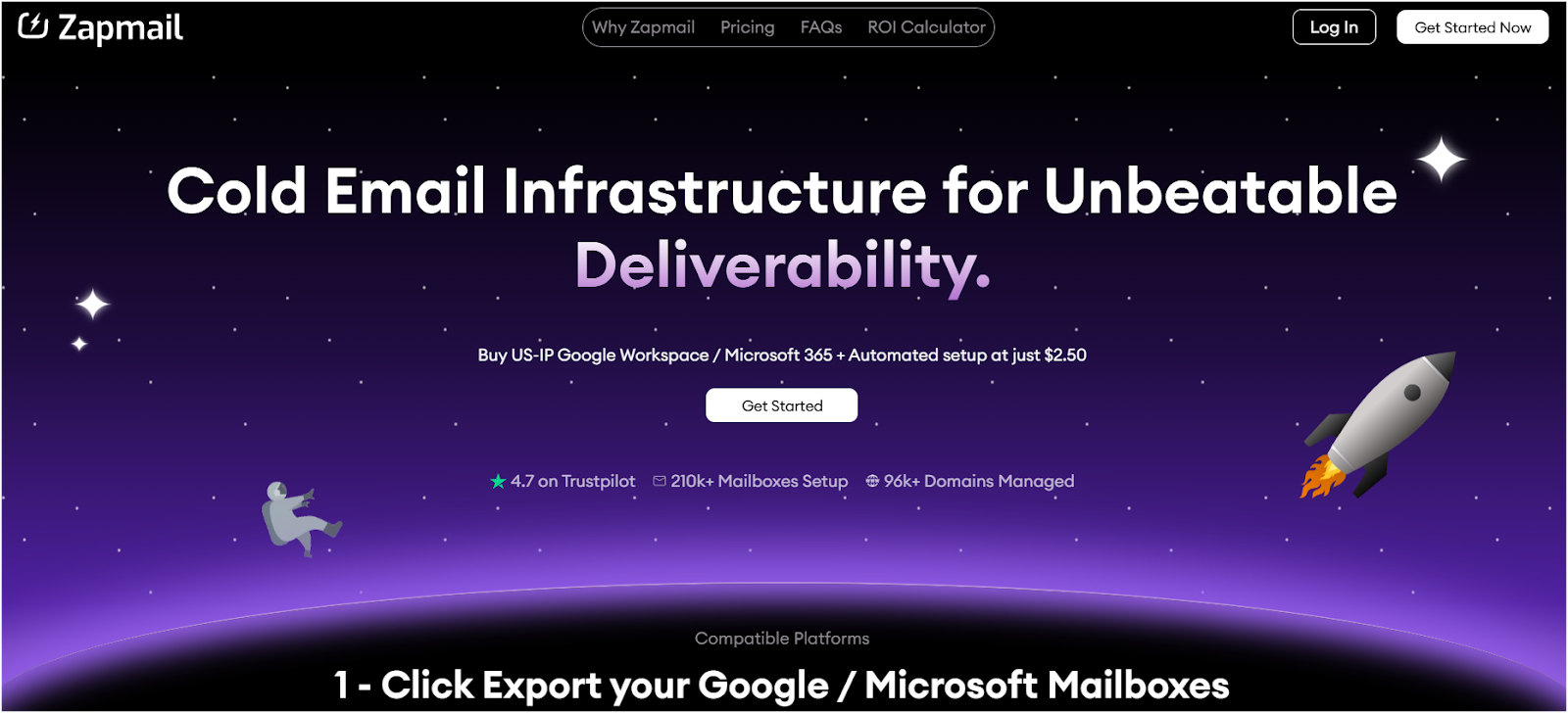
Zapmail is everywhere in 2025—low prices, modern dashboard, and bold claims on deliverability.
It promises Google Workspace inboxes for just $2.50/month, full DNS setup, and instant exports to tools like Instantly, Smartlead, and ReachInbox.
On the surface, it looks like the Mailforge or Infraforge killer.
But under load, cracks appear.
What Zapmail Actually Does?
Zapmail offers bulk Google Workspace and Microsoft 365 mailboxes at low cost, bundled with:
- Auto DKIM, SPF, and DMARC setup
- Workspace/account segregation
- DNS record management
- Bulk profile updates
- Seamless integrations with outreach tools
Each email account is set up with the necessary technical configurations to ensure high deliverability and reliable performance.
It’s marketed to agencies as an all-in-one, fast-to-deploy email infrastructure platform.
Zapmail Pricing
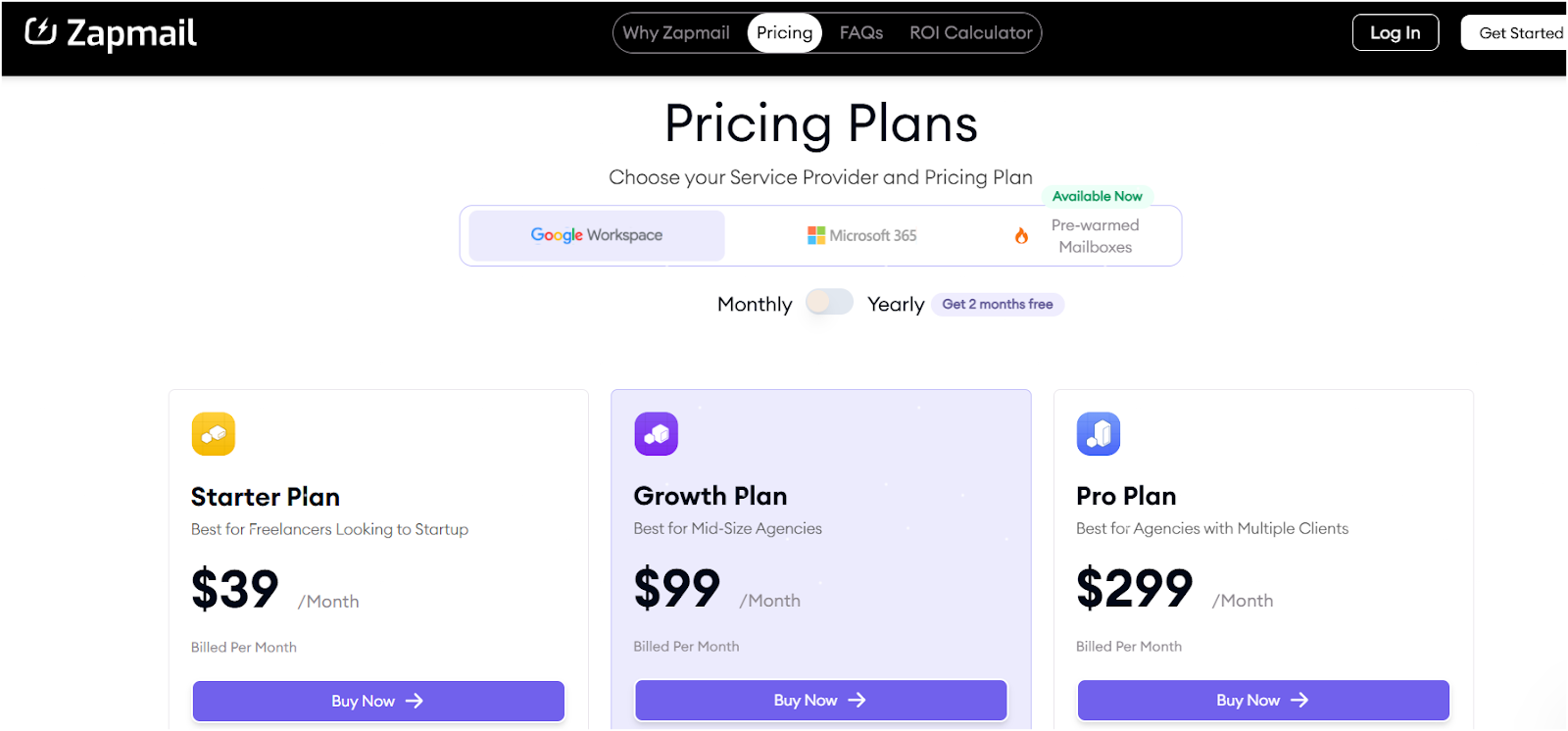
- Domains sold separately (starting at $13 for .com)
- No long-term contract required
- Microsoft and Google inbox options are available
Pros and Cons of Zapmail
Best For
- Solo founders just starting out
- Agencies testing campaigns at low volume
- Teams that want fast infrastructure without backend control
Zapmail is the easiest on-ramp to cold email infrastructure today.
It’s fast, cheap, and integrates smoothly.
But don’t confuse speed with durability.
If you scale hard or need full deliverability oversight, you’ll outgrow it fast.
#13. Supermail – Not Infra, Just an AI Email Writer With a Confusing Name
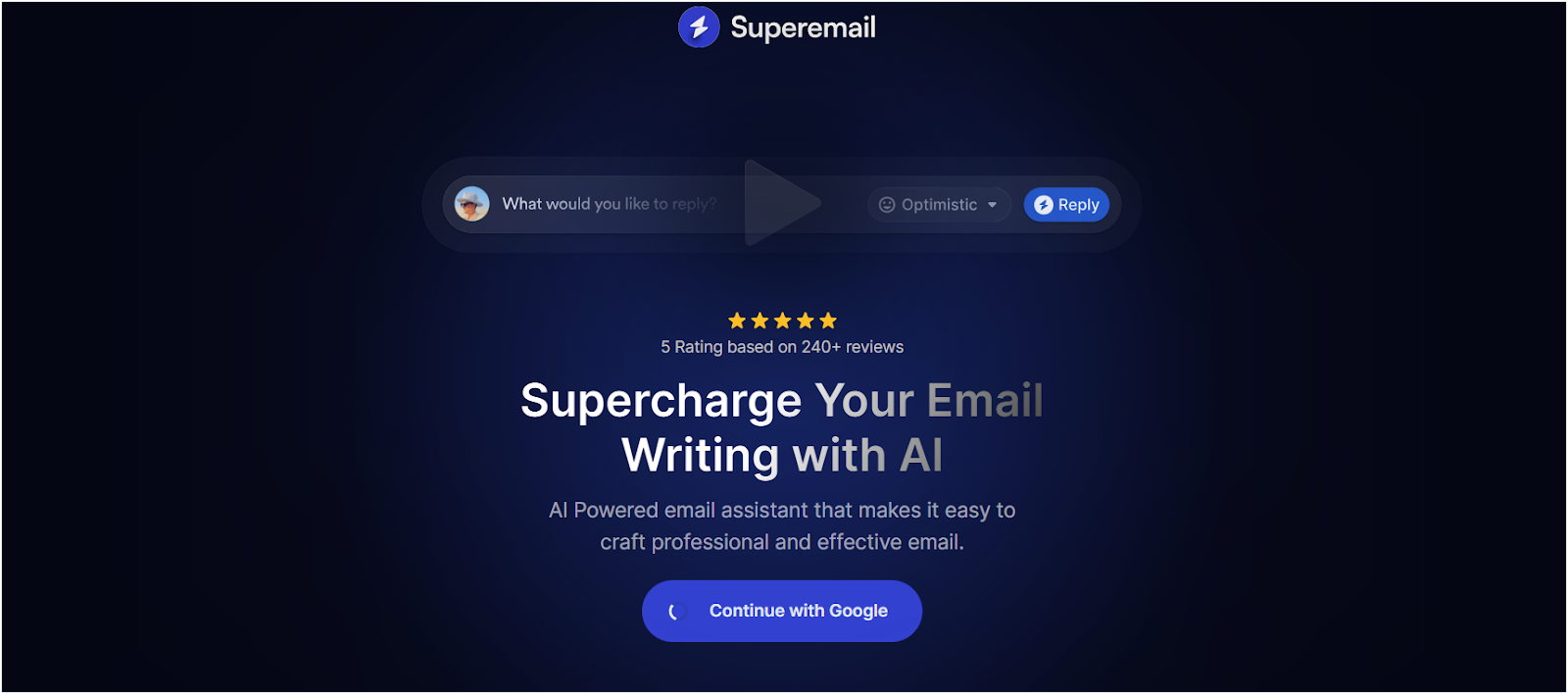
At first glance, Supermail sounds like an infrastructure tool, maybe inbox hosting or a warm-up service.
But it's not.
Supermail is simply an AI writing assistant built to help you draft better emails, faster.
Think Grammarly meets ChatGPT, but tailored for cold email or business communication.
There's no inbox setup, no domain management, and definitely no deliverability tooling here.
What Supermail Actually Does?
Supermail helps users write emails, that's it.
It gives you a simple UI where you describe the email you want, and it generates the content using AI.
Key use cases:
- Writing sales follow-ups
- Polishing professional replies
- Creating outreach templates
- Summarizing long threads or responses
It's built for speed and simplicity, not for managing your infrastructure or cold outreach campaigns.
Supermail Pricing
Supermail doesn't have transparent pricing listed publicly on the landing page.
Based on similar AI tools, expect:
Pros and Cons of Supermail
Best For
- Founders or execs needing quick email polish
- Sales reps looking to speed up responses
- Non-native speakers writing professional emails
- Teams wanting basic writing assistance without full CRM integration
Supermail is not a cold email infra tool; it’s just an AI email writer.
If you’re looking to land in the inbox, manage domains, or set up mailboxes, look elsewhere.
But if you need help sounding professional or crafting replies fast, it can be a helpful companion.
#14. Scalemail – List-Building Tool as Email Infra
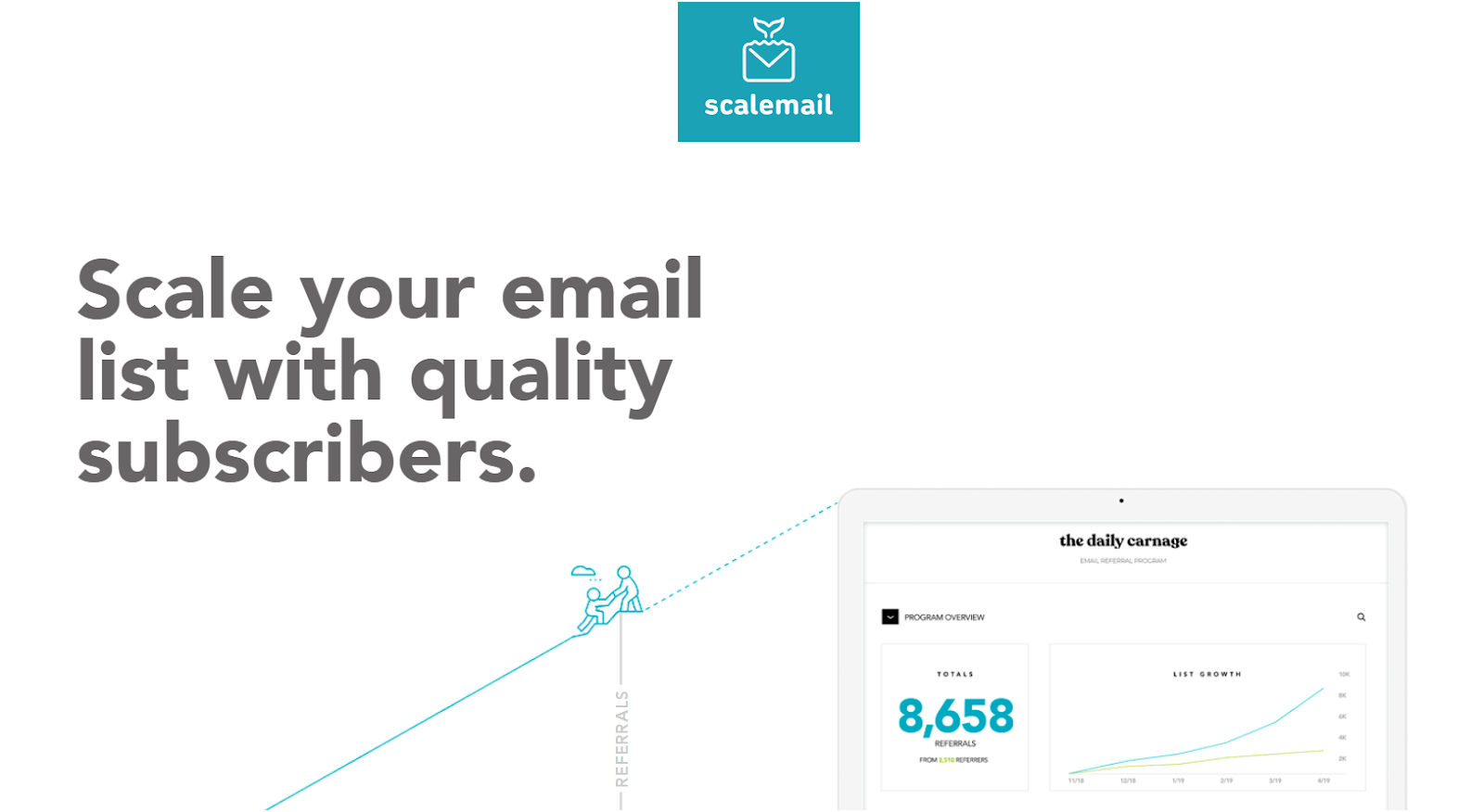
Let's get one thing straight: Scalemail isn't cold email infrastructure.
It's a referral-based email list growth tool designed for newsletter operators, publishers, and media brands trying to build large subscriber bases, not send outreach at scale.
Yet some mistakenly lump it in with tools like Mailforge or Infraforge. It's not even in the same category.
What Scalemail Actually Does?
Scalemail is a white-labeled email referral system.
It plugs into your newsletter or existing email list software (like Mailchimp, Beehiiv, or ConvertKit) and offers a gamified referral dashboard to help grow your list through word-of-mouth.
Their team handles onboarding and dashboard customization.
But you don't get:
- Mailbox provisioning
- DNS setup
- Deliverability monitoring
- Cold outreach capabilities
It's built for acquisition, not sending.
Scalemail Pricing

- 3-month trial required
- No free tier
- Tax not included
Pros and Cons of Scalemail
Best For
- Newsletters focused on organic subscriber growth
- Brands that want to gamify referrals inside their email funnel
- Media companies are growing massive, engaged lists
Scalemail is not a cold email tool; it’s a list-building widget for owned audience growth.
If you’re looking for mailboxes or infra, this isn’t your stop.
Stick to Scalemail if your goal is subscribers, not sends.
#15. PremiumInboxes – High-Volume Inbox Reseller Built for Cold Email Agencies
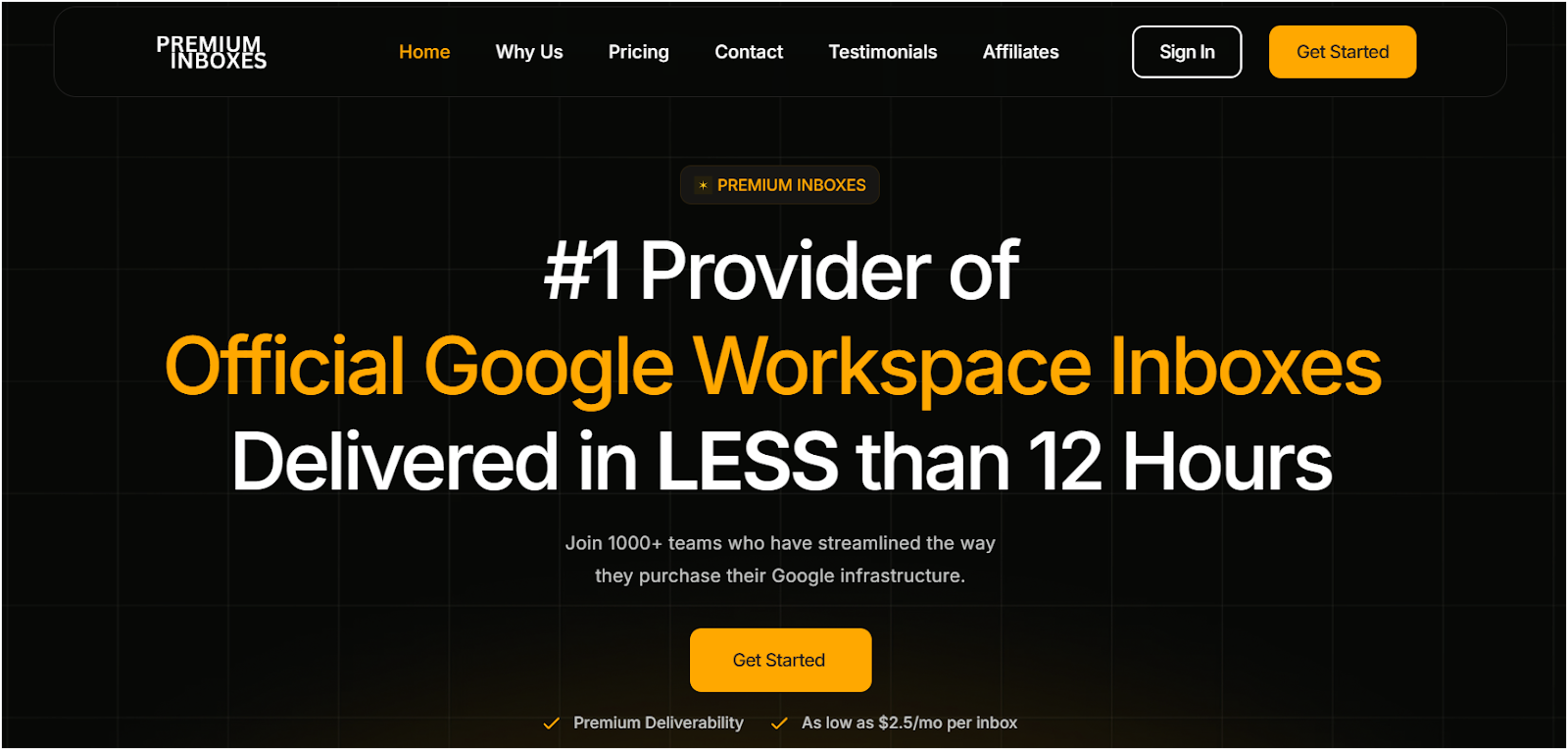
PremiumInboxes doesn't pretend to be something it's not.
It's a pure-play inbox provisioning service, optimized for Google Workspace accounts, with fast turnaround, and technical setup done for you.
No outreach platform. No CRM. No warm-up automation.
Just inboxes, at scale, fast, and cheap.
It's what most cold email agencies end up using when they outgrow sketchy Fiverr sellers but aren't ready to build their own infrastructure.
What PremiumInboxes Actually Does?
PremiumInboxes sells bulk Google Workspace accounts pre-configured for cold outreach.
Each inbox comes with DNS records (SPF, DKIM, DMARC), a US IP address, and a ready-to-send status.
Key deliverables:
- 12-hour (or faster) account delivery
- Fully configured domains
- Profile customization
- Inbox replacements if something goes wrong
- Upload-ready format for Instantly, Smartlead, and other outreach tools
There's no dashboard, warm-up engine, or outreach pipeline. It's just infrastructure as a service.
Premium Inboxes Pricing
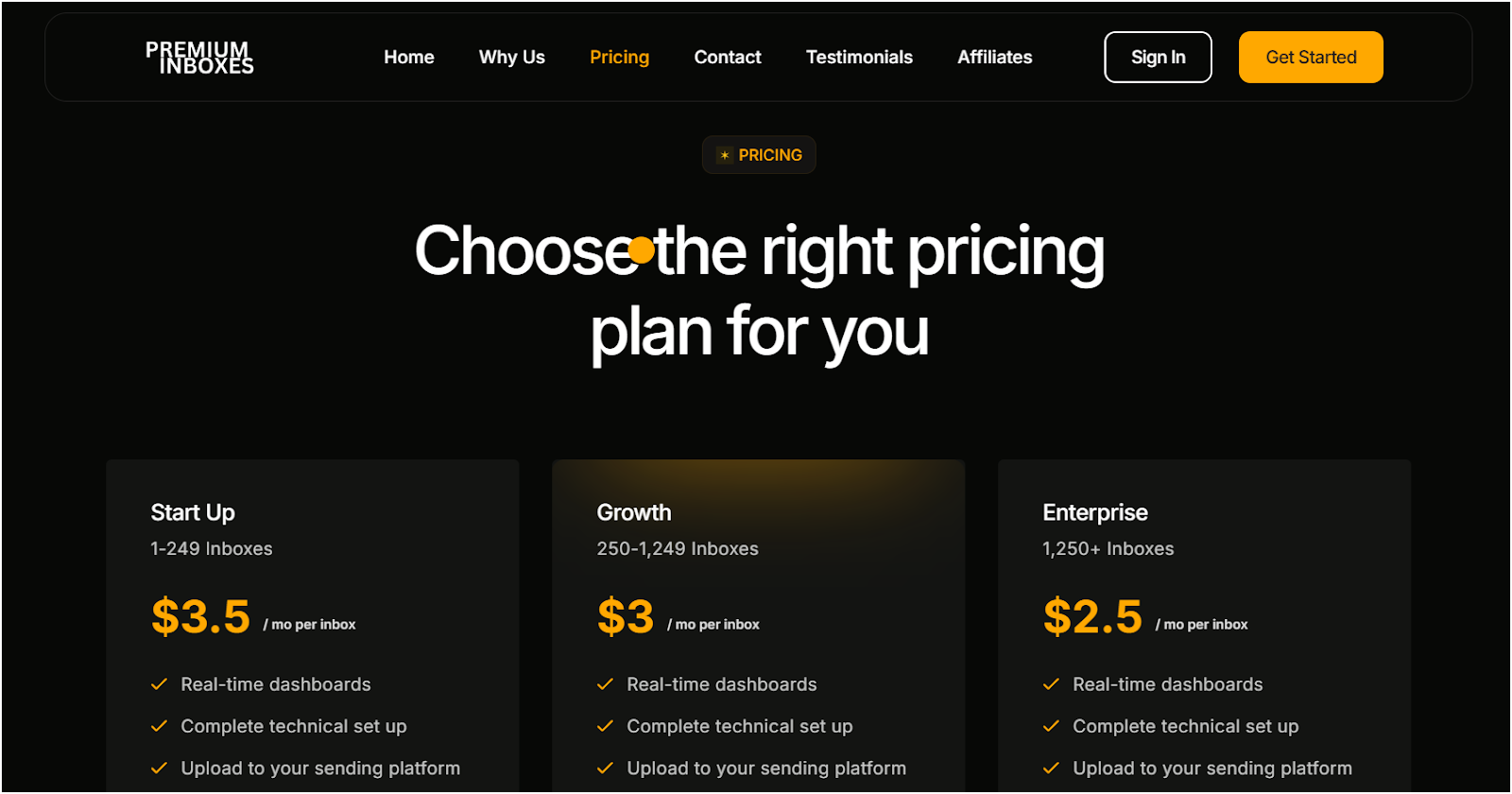
PremiumInboxes uses volume-based pricing. Simple and aggressive.
All inboxes come with full setup, US IPs, and upload-ready formatting.
Pros and Cons of Premium Inboxes
Best For
- Cold email agencies are scaling fast and need inboxes in bulk
- Teams that already use Instantly, Smartlead, or Mailforge
- Agencies are tired of unstable inbox sellers on marketplaces
- Ops teams managing multiple client domains
PremiumInboxes is exactly what it claims to be, nothing more, nothing less.
It won’t manage campaigns or handle warm-up, but if you need 500 working inboxes by tomorrow morning, it gets the job done.
#16. CheapInboxes – Budget Inbox Provider With No Frills (and Few Safeguards)
CheapInboxes does one thing: give you cheap inboxes.
No warm-up, no automation, no integrations. Just volume. Cheap.
If you're bootstrapped and want to blast emails at scale with minimal upfront cost, this might catch your eye.
But, when you trade features for price, you also risk trading deliverability for blacklists.
What CheapInboxes Actually Does?
It’s a low-cost email hosting provider focused on high-volume mailbox provisioning.
The platform supports custom domains and standard email protocols (IMAP/POP3/SMTP), making it easy to plug into basic sending tools.
You don’t get:
- DNS automation
- Inbox health tracking
- Deliverability optimization
- Smart sending or warm-up tools
Without proper setup or warmup, using CheapInboxes can trigger spam filters and harm your email deliverability.
This is not an infra tool, it’s a bulk hosting shortcut.
CheapInboxes Pricing
Pros and Cons of CheapInboxes
Best For
- Freelancers or solopreneurs experimenting with outreach
- Small teams looking to test campaigns on a budget
- Bulk mailbox provisioning for non-critical use cases
#17 Frost Mailer – Cheap Google + Outlook Mailboxes, But High-Risk at Scale
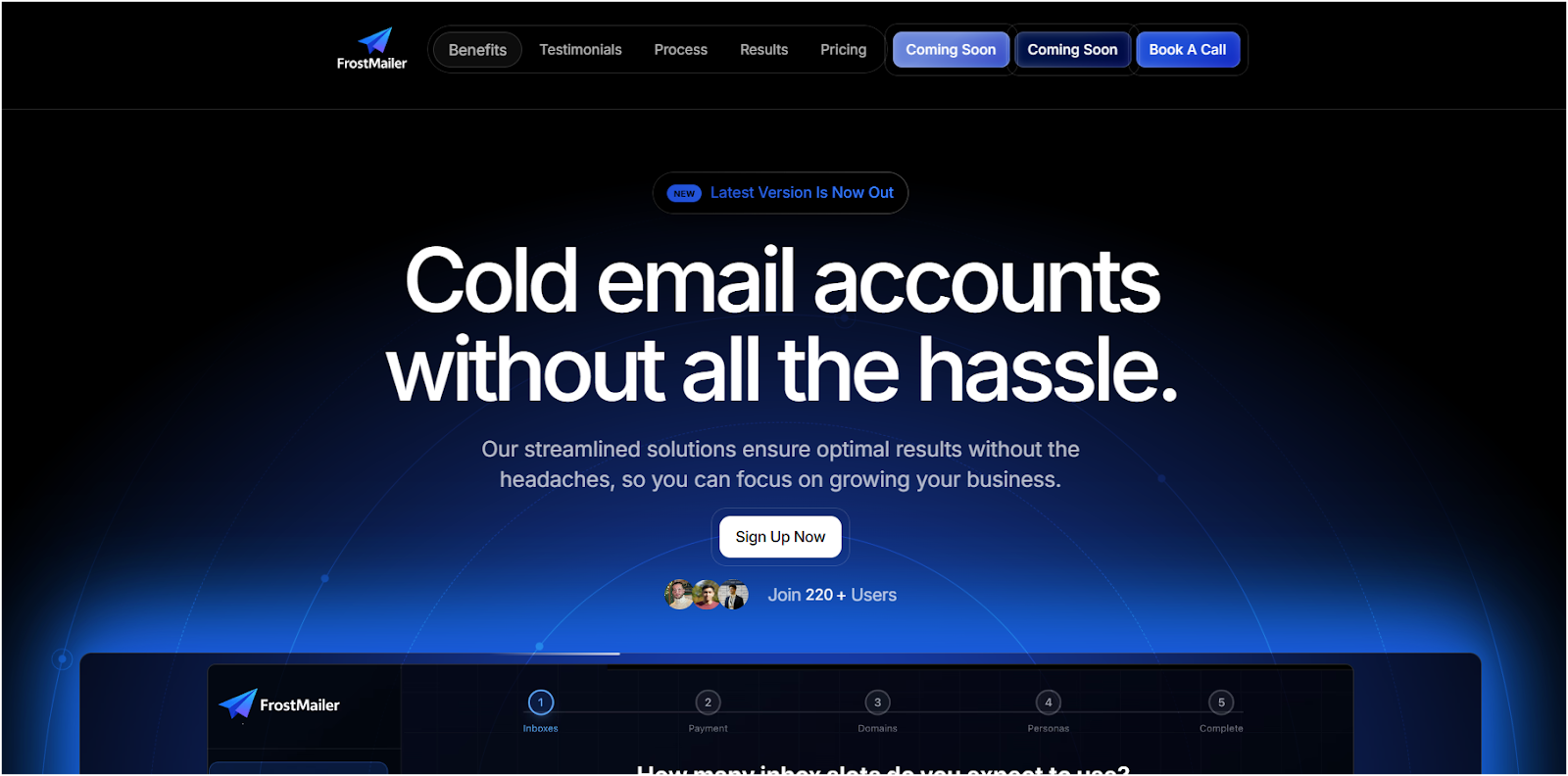
Frost Mailer offers Google Workspace and Outlook accounts with full DNS setup — starting at just $1.50 per mailbox.
It's one of the cheapest mailbox vendors in the market.
But here's the catch: no warm-up system, no email infra monitoring, and zero control once setup is done.
It's a vendor-style model, great for getting started, but not something you scale serious outreach with.
What Frost Mailer Promises
- US IP Google Workspace inboxes
- Outlook accounts at $1/inbox
- Full DNS config (SPF, DKIM, DMARC)
- Fast onboarding (48 hours)
- No domain charges — pay only for inboxes
- Hands-off support and setup
Their process: Fill a form, wait 48 hours, and you get ready-to-send inboxes.
Good for quick starts. Risky for long-term outreach hygiene.
Key Features
- Google & Outlook Inbox Packages: Choose your platform, no hidden fees
- DNS Setup Done For You: SPF, DKIM, and DMARC all pre-configured
- Volume Discounts: Pricing gets lower as you scale
- Support on Standby: They pitch 24/7 live support for account issues
- No Frills, Just Accounts: You bring your tool — they provide infra
But you won't find:
- Warm-up
- DNS alerts
- Blacklist monitoring
- Deliverability scoring
- Bounce or spam feedback
Frost Mailer Pricing
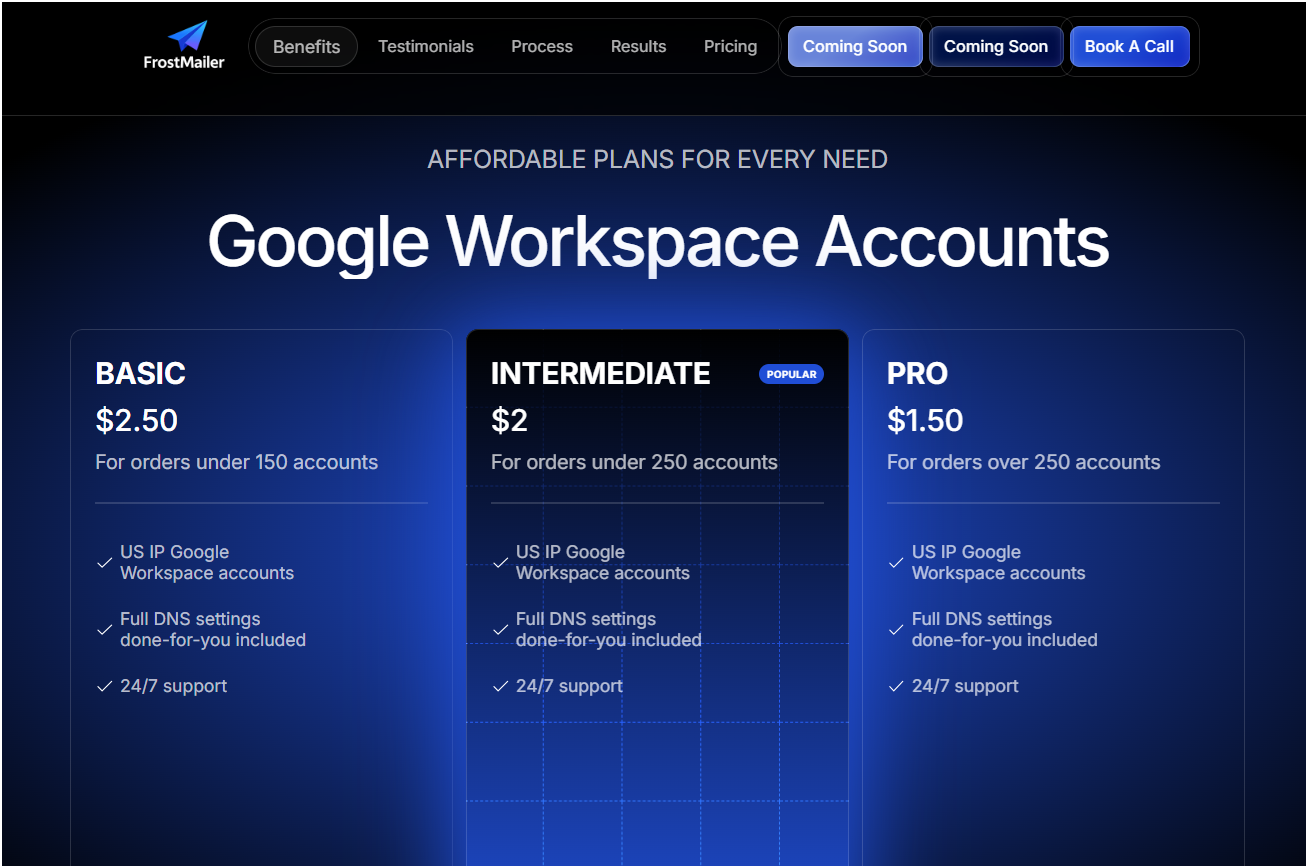
Note: No warm-up included. You’ll need tools like Mailreach or Warmforge separately.
Pros and Cons of Frost Mailer
Best For
- Agencies that already use warming tools (and need inboxes in bulk)
- Founders testing a cold email campaign without much tech setup
- Lead gen teams wanting throwaway Gmail/Outlook inboxes
- Not for: Anyone managing deliverability at scale or needing alerting/control
Frost Mailer is a budget-friendly inbox provider — fast and cheap, especially if you don’t want to mess with DNS or domain setup.
But with no built-in warm-up, no infrastructure monitoring, and limited support post-setup, it’s not built for long-term deliverability success.
It works… if you patch it with external warm-up and deliverability tools.
#18 F60 Host – Ultra-Cheap Google Workspace, But Not Built for Cold Email Outreach
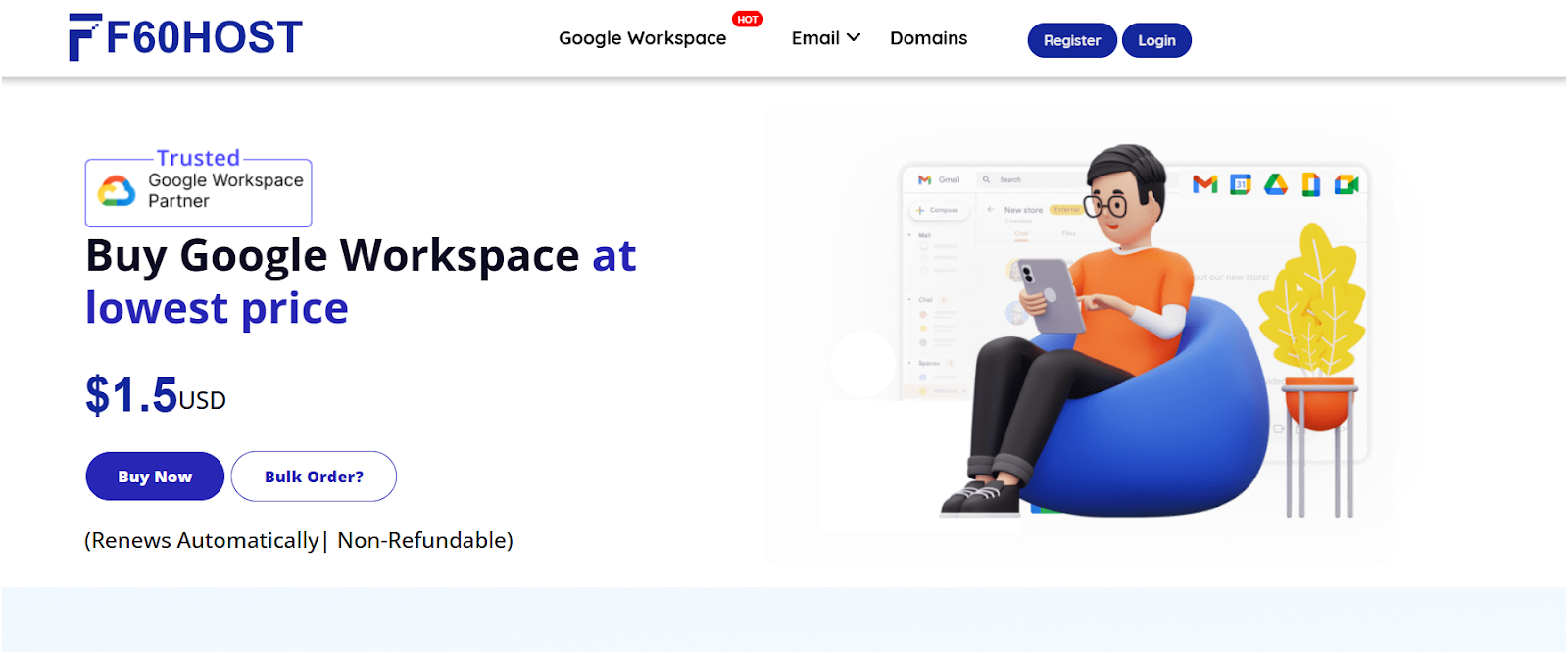
F60 Host markets itself as a Google Workspace reseller offering some of the cheapest inboxes on the market, as low as $1.50/month.
They're not hiding it: it's meant for affordability, not scalability.
And while the pricing is attractive, these inboxes come with serious limitations that can break your cold email campaigns if you're not careful.
What F60 Host Actually Offers
- Google Workspace "Business Starter Lite" for $1.50/month
- 30 GB cloud storage per user
- Custom domain emails
- No admin panel or user management
- No upgrades or domain transfer options
- Support via chat and email (free for 6 months)
It's cheap but locked down. No access to backend admin tools means no ability to configure SPF, DKIM, DMARC, or manage bulk inbox behavior.
Key Features
- Super Cheap Pricing: Starts at $1.50/month or $15/year
- Google Workspace Reseller: Offers Gmail, Drive, Docs, Meet, etc.
- No Admin Console: You can't manage users or settings
- No Scalability Options: Cannot upgrade or migrate domains
- No Email Infra Control: You're locked out of DNS setup or warm-up
If you're buying this for mass cold outreach, you're building on quicksand.
F60 Host Pricing
Bulk orders supported, but still non-refundable and non-upgradable.
Pros and Cons of F60 Host
Best For
- Freelancers or solopreneurs needing a basic branded Gmail
- Personal or internal business emails with no scale needs
- Teams on tight budgets, not sending cold outreach
Not for: Cold email agencies, SDR teams, or founders who need DNS control and inbox warm-up.
F60 Host gives you access to branded Gmail at rock-bottom prices.
But for cold outreach, you’ll have no control over email infrastructure, which means poor deliverability, no visibility, and major risk as you scale.
Use only if you’re sending low volume or want throwaway inboxes for internal communication, not for serious cold email workflows.
🔴 Tier 5: The Big Players (Google/Outlook/Sendgrid). Why You Still Need Infra On Top
Here’s a comparison table that clearly lays out Google Workspace, Outlook, and SendGrid for cold outreach use cases:
At first glance, using Google Workspace, Outlook, or SendGrid for cold outreach seems logical. They’re reliable, secure, and built by giants. However, cold email remains a highly effective outreach strategy for B2B sales, offering efficiency and measurable results.
But here’s the problem: none of them were made for cold outreach.
These tools are optimized for transactional or internal communication, not for volume-based, cold email sending. If you’re running outreach at scale, you’ll eventually hit limitations.
Here’s what they don’t provide out of the box:
- No custom tracking domains
- No warm-up or reputation monitoring
- No bounce alerts or blacklisting notifications
- No control over IP rotation or domain health
If you’re serious about cold outreach, you’ll need infrastructure like Warmforge, Infraforge, or a custom SMTP layered on top.
Let’s break down each tool below.
#19 Google Workspace – Great for Business Email, But Not for Cold Outreach
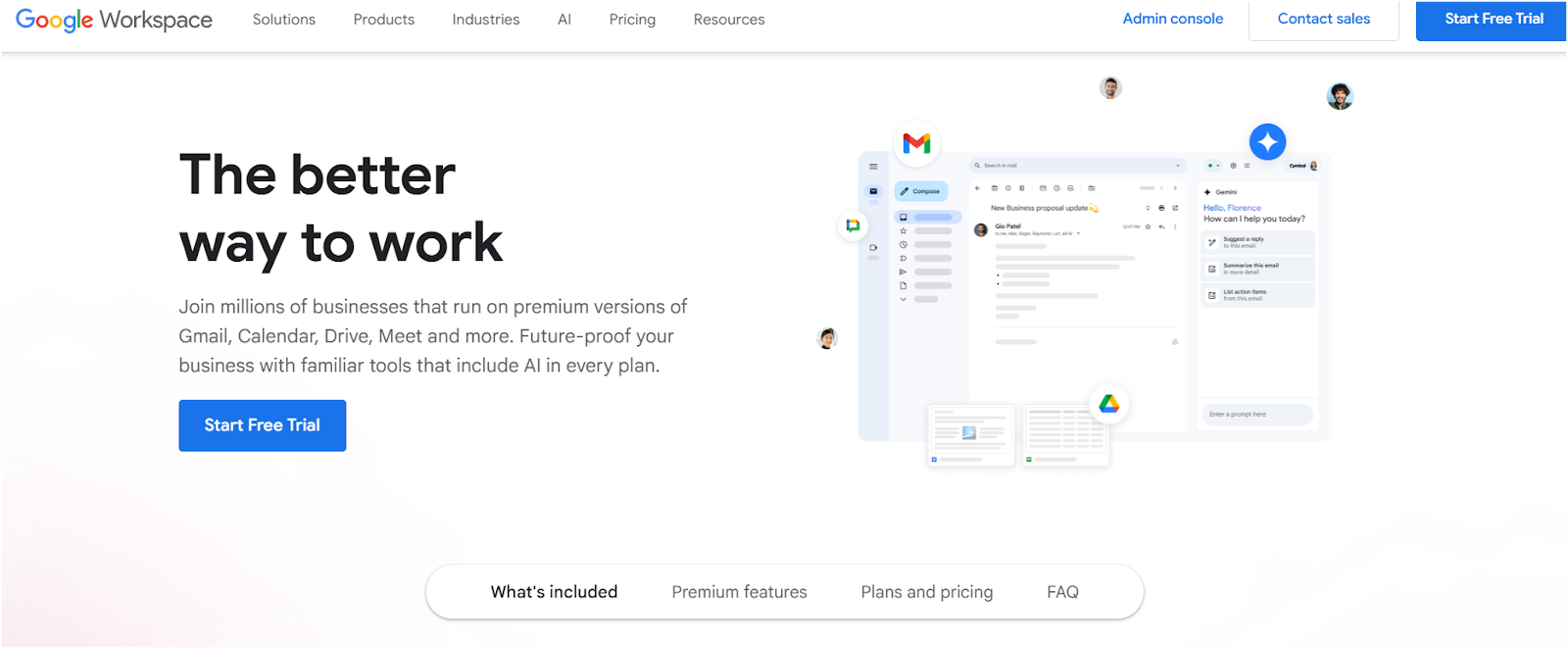
What it's best for: Secure, branded inboxes for your team and internal communication.
Cold email drawbacks:
- You're tied to shared Google IPs — high risk for domain flagging if misused.
- No built-in warmup or custom tracking domain support.
- No bounce or blacklist monitoring.
- Sending limits (2,000/day per account max) without clear visibility or control.
Google Workspace Pricing
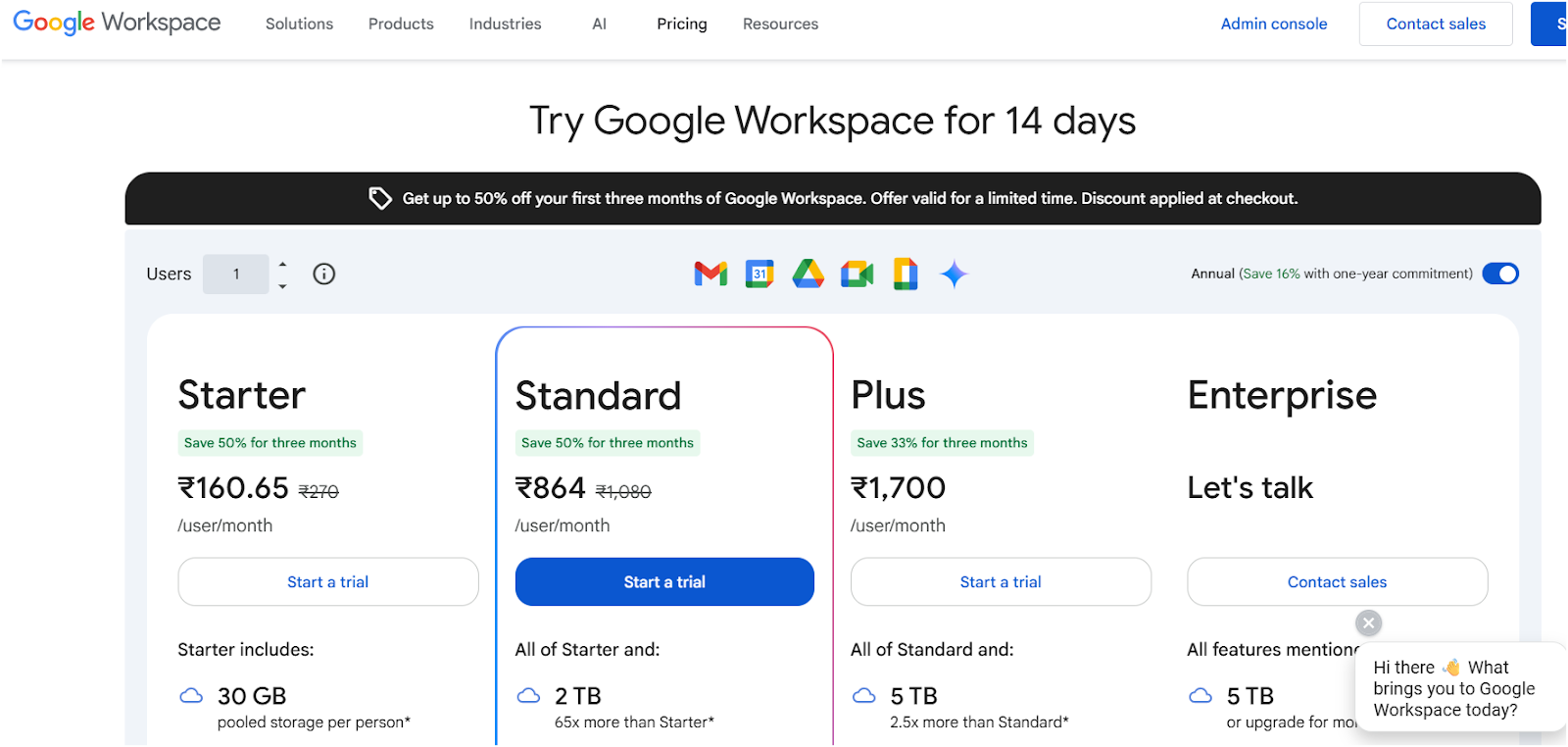
Great for inbox creation and management.
But for sending cold emails at scale, you’ll still need Infraforge or Warmforge.
#20. Outlook (Microsoft 365) – Enterprise-Grade Email, Limited for Outreach
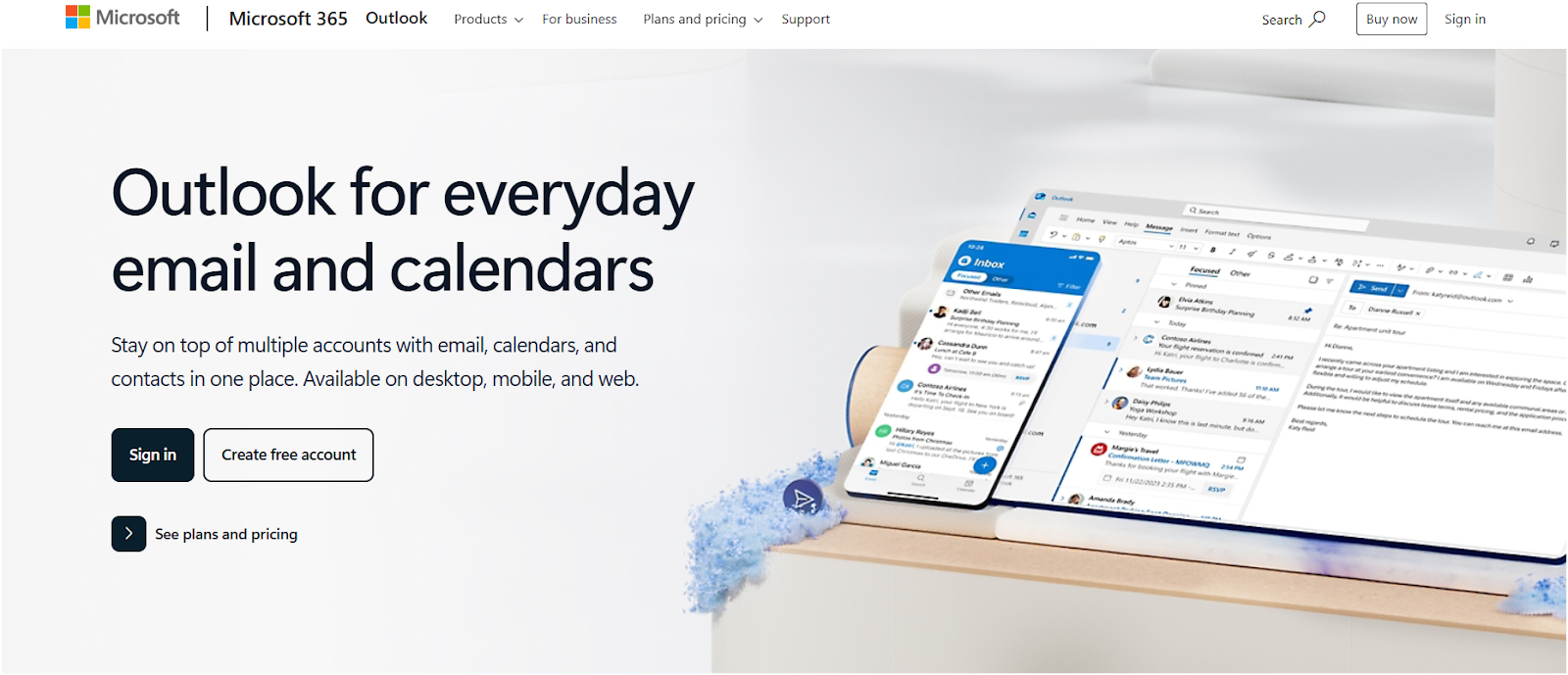
What it does well: Integrates tightly with Windows and the Office Suite. Smooth experience for internal or customer-facing emails.
Cold email drawbacks:
- Shared Microsoft IPs, which are not safe for cold outreach volume.
- No dedicated bounce tracking or blacklist notifications.
- Strict throttling and reputation-based limits.
Outlook Pricing
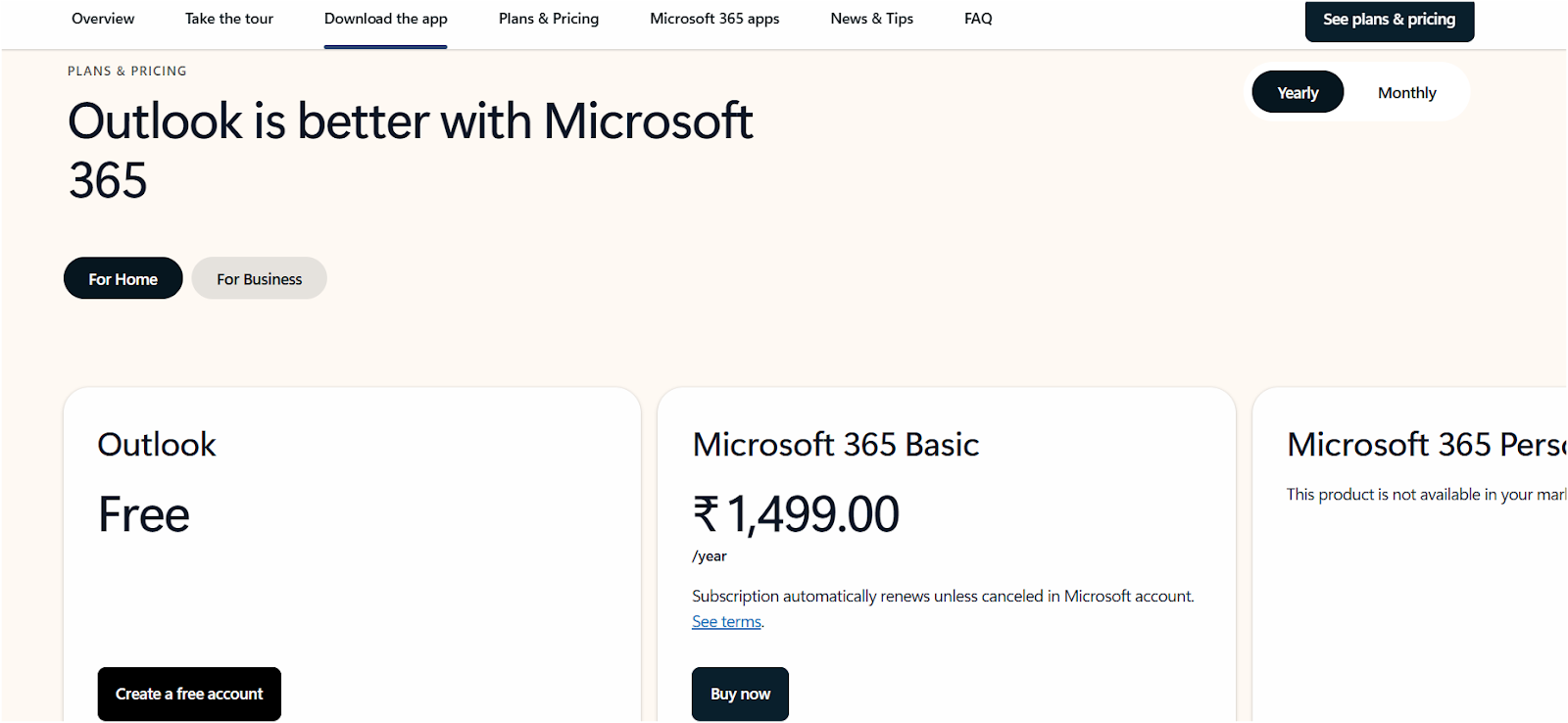
If you’re doing personal or customer comms, it’s fine. But if you’re sending cold outreach, Outlook will throttle you hard.
Pair with a sending infra or warmup tool for better control.
#21. SendGrid – Built for Email Volume, But Not for Cold Campaigns
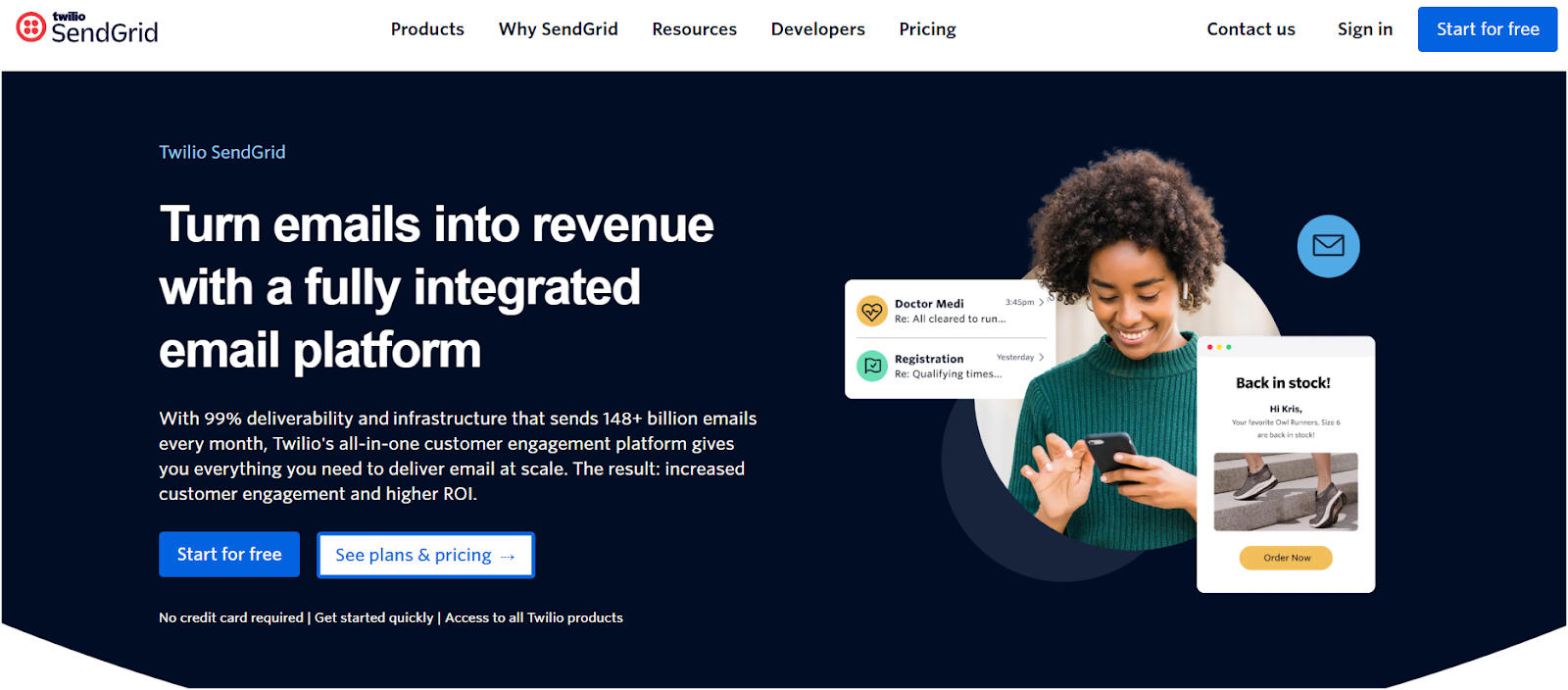
What it's good for: Transactional and marketing emails at high scale. Trusted by SaaS teams for onboarding flows, receipts, and alerts.
Cold email limitations:
- Free & Essentials plans don't include dedicated IPs.
- You'll still need external tools for inbox warm-up, blacklist monitoring, and bounce alerts.
- No native enrichment or contact management — it's just the mail pipe.
Sendgrid Pricing (Global)
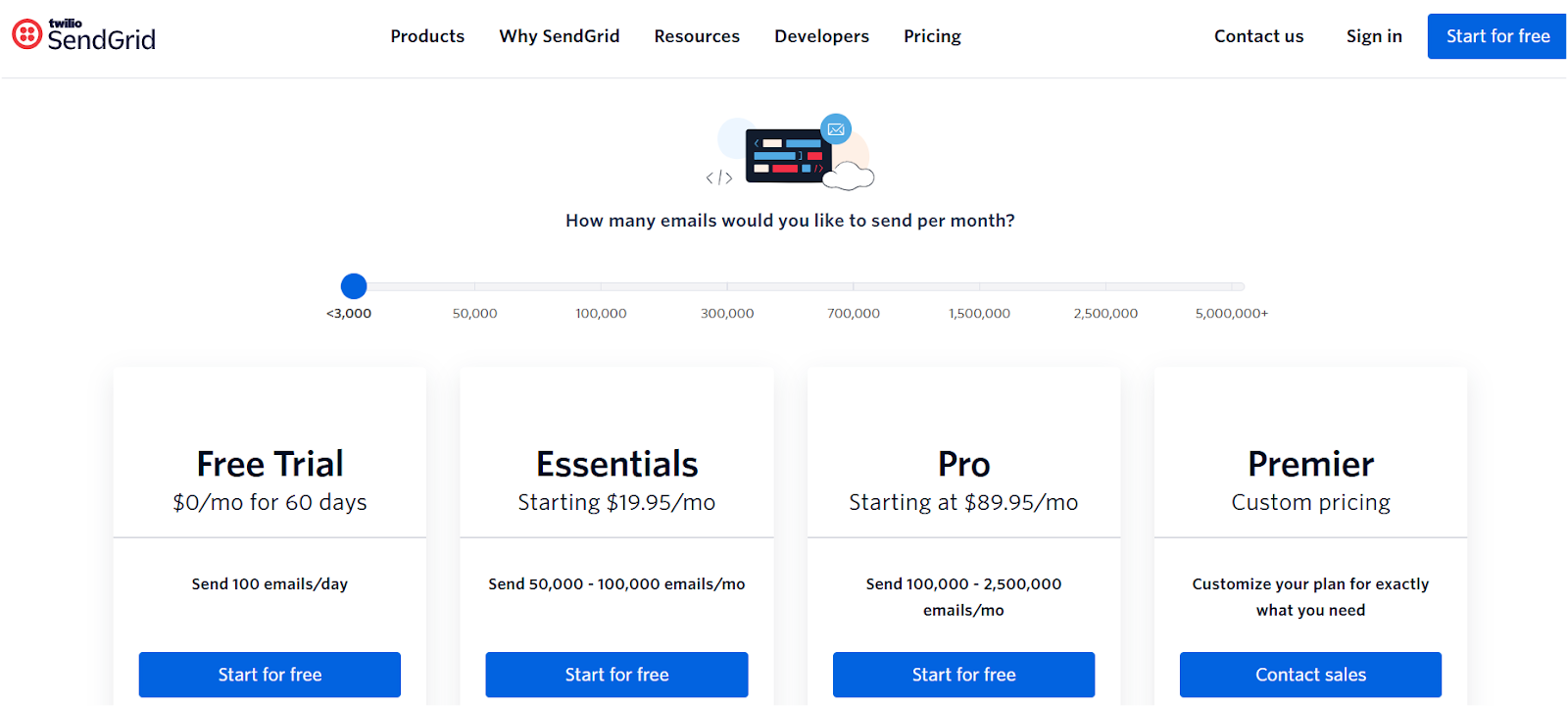
SendGrid’s Pro or Premier plan is more reliable for scale, but you still need tools like Warmforge to warm the IP, track blacklist issues, and manage domain health.
🧊 Final Verdict: Cold Email Infra Tools - From Best to Risky
Final Tip:
To maximize your cold email results, always take time to research and understand your target audience. Crafting personalized and relevant messages that address their specific needs and pain points will help your outreach stand out and drive better engagement.
✅ Want Infra That Actually Gets You Replies?
Try Mailforge – built for cold email, not newsletters.
→ DNS + inbox warmup + blacklist alerts in one stack
→ Zero setup. Start sending in <10 minutes.
[Get started with Mailforge now]